Planting and care in the open field. Buttercup creeping: description and application.
Name of this wild flower can be found in songs and poems, although washed away it is not at all romantic - the buttercup is nicknamed so for the "fierce" poisonous juice that corrodes the skin. However, the attractive appearance of the plant at all times encouraged rural young men to collect it in bouquets and give it to their beloved girls. Traditional healers and healers pluck buttercups for another purpose - to harvest raw materials and prepare medicinal decoctions, tinctures and ointments. Today we will tell you all about the beneficial properties of buttercup and its use in medicine.
Full description of buttercup
The ranunculus plant belongs to the family of the same name, and in Latin it is called ranunculus, which means “little frog”. Not at all green color or the specific shape of the flowers is the reason for such a funny name. It's all about the buttercup's devoted love for moist soil and sunlight. Like a frog basking on a mossy stone, the ranunculus settles along the banks of small, swampy reservoirs, and stretches its delicate petals towards the warm sun.
Appearance
Buttercup is an annual or perennial herbaceous plant with an ordinary or tuberous rhizome, with a branched straight or prostrate stem. In height, the buttercup can reach one meter, but more often it is a short (20-30 cm) flower. The shape of the leaves of the buttercup is very diverse, and, in the same plant, the lower castings can be long, palmate or spatulate, and the upper ones are short and pinnate. Their length and width does not exceed six centimeters, and at the place of attachment to the stem there is a so-called "honey" hole, covered with a thin scale.
Bright, beautiful buttercup flowers are distinguished by their regular shape, but tiny size - no more than two centimeters in diameter. They can grow singly or gather in lush inflorescences. At the end of flowering, fruits are tied, which in biology are called "multi-nut". When they ripen and burst, the seeds spill out onto the ground, usually covered with fine hairs and slightly convex. Each polynutlet contains several dozen seeds, so the buttercup has no problems with reproduction.
Color spectrum
Usually, with the word "buttercup" we imagine small yellow-orange flowers, but the color range of these plants is very extensive. In nature, there are also snow-white, bright red, pale pink, sky blue and even lilac buttercups.
habitats
Buttercup is a frequent guest of green meadows, river valleys and swampy backwaters throughout Europe, especially in the Alps and the Pyrenees. This plant is found in Asia, and in the North Caucasus, and in Western Siberia. Buttercup grows almost throughout the northern hemisphere, it is absent only in the Far North and the hot south, where the climate is completely unsuitable. Buttercup is well known to the inhabitants of Russia - these flowers can be found in almost every field, especially if it is crossed by a stream, or there is a swamp nearby.
Buttercup species
About six hundred species of buttercup are known to science, all of them are poisonous to varying degrees, and useful to varying degrees. Traditional medicine in many countries of the world adopted these flowers, they found their place in the bins of Russian healers.
Currently, the following types of buttercup are used to treat a wide range of diseases:
Bolotny;
Creeping;
Multicolored.
Caustic (night blindness);
Poisonous;
Buttercup caustic (night blindness)

Night blindness has the scientific name ranunculus acris and has a very wide range of habitats. It is the caustic buttercup that is best known to the layman, and it is precisely its golden-sunny petals that make us consider all buttercups yellow. Night blindness is one of the tallest plants in the ranunculus family; for an adult, it can reach the waist. The stem of the buttercup is straight, ascending, covered with fine adpressed hairs and branching at the end. The leaves have irregular shape and normally can be very different from each other.
The rhizome of night blindness is very short for such a tall plant, it consists of numerous filamentous processes collected in a bundle. Bright flowers most often appear at the ends of the branches individually, they almost never form large inflorescences. Why is this pretty plant nicknamed “night blindness”? Of course, for the ability of poisonous juice to irritate the mucous membranes. If, after collecting the ranunculus, caustic rub the eyes, they will water heavily due to the alkaloid protoanemonin. In rural areas, since ancient times, there has been an opinion that chickens should not be allowed to graze in a ranunculus field, otherwise they will go blind. But this "horror story" has not been confirmed by science.
The use of buttercup caustic in medicine
For medical purposes, stems and leaves of night blindness are used, the juice of which contains alkaloids, saponins, flavonoids, glycosides and tannins. The main alkaloid in the buttercup is called protoanemonin, and it is directly related to poisonous sea anemones.
Buttercup acrid has on human body the following benefits:
Tonic;
bactericidal;
Anti-inflammatory;
Immunostimulating;
Hemostatic;
Accelerating metabolic processes;
Stimulating hematopoiesis and raising the level of hemoglobin.
Buttercup-based preparations are used to treat the following diseases:
Inflammation of the lymph nodes;
Hydradenitis;
Enlargement of the spleen;
Buttercup poisonous
The scientific name of this buttercup species is ranunculus sceleratu. A one-biennial low (10-70 cm) plant with a branched, hollow stem inside blooms with tiny (7-10 mm) pale yellow flowers. But the leaves of the poisonous ranunculus are bright green, shiny and more juicy and fleshy than those of night blindness, so more juice can be obtained from them. By the way, it contains much more poisonous alkaloids than the juice of the previously described species, which is why the poisonous buttercup is called that.
This is interesting! Buttercup has fluffy seeds that do not get wet in water and do not rot. Moreover, under top layer their peel has special cells in the form of empty cones, thanks to which the seeds cannot sink in water.
The use of buttercup poisonous in medicine
A weaker solution of poisonous ranunculus juice is excellent for washing eyes with barley and disinfecting festering wounds. If an abscess ripens on the skin, you need to attach chopped fresh grass to this place and wrap it overnight. The poisonous juice will pull the inflammation out, and the painful abscess will open. Freshly squeezed concentrated juice of poisonous ranunculus can also remove warts if applied regularly several times a day. And in a hot infusion of poisonous ranunculus, it is good to soar legs at night with rheumatism.
Important! For internal use you must first dry the raw material so that volatile alkaloids evaporate from the poisonous ranunculus.
Decoctions and infusions from a dried plant help with the following diseases:
buttercup creeping

Buttercup creeping (ranunculus repens) is no less poisonous than the species described above, but it is called that because of the short stems that creep along the ground, which often take root. Thus, we can say that the creeping ranunculus has a combined type of reproduction - vegetative-seed. He does not need many seeds, so the plant blooms large for a buttercup (2 cm in diameter), single honey-yellow flowers crowning each stem. Flowering continues for a long time - from late spring to late summer. The buttercup is creeping, and unlike its counterparts, it does not favor the sun, it prefers the shady shores of forest lakes and swamps.
The use of buttercup creeping in medicine
The juice of this plant perfectly kills microbes, and also tones the body, heals and anesthetizes wounds. Warts are removed with crushed fresh grass, scabies is treated with diluted juice, and pulp is made from fleshy stems and tied to boils and abscesses so that they ripen and open as soon as possible. Compresses with creeping ranunculus well relieve pain in the joints and back, and washing and baths effectively kill the fungus on the legs.
The external use of buttercup creeping can alleviate the course of the following diseases:
Scrofula;
To prepare an infusion for internal use, you need to take either only creeping buttercup flowers or dried grass. For a glass of boiling water, you will need one teaspoon of chopped raw materials. Dishes with infusion should be wrapped warmly for half an hour immediately after steaming, and then strain (very carefully!) And take one tablespoon three times a day before meals. This remedy is excellent for chronic headaches, migraines, dropsy, stomach and intestinal bleeding.
Fresh flowers of buttercup creeping significantly alleviate the condition of patients with malaria. Since the attacks of this disease overcome a person mainly in the evenings, it is necessary to grind the flowers in the morning and apply the resulting slurry to the inside of the wrists and elbows, where the large blood vessels pass. In this simple way, you can prevent or at least mitigate an attack of malaria.
When applying the concentrated juice of creeping ranunculus externally, this highly toxic substance should not be left on the skin for more than fifteen minutes, otherwise ulceration or even will develop.
Banewort
In Latin, the burning ranunculus is called ranunculus flammula. This is a compact, low (20-50 cm) plant with an upright or slightly sloping stem and two types of leaves: the lower ones are long-leaved, and the upper ones are wide and sessile. Burning ranunculus blooms with single small (12 mm in diameter) pale yellow or lemon flowers. The fruit of this plant is not at all the same as that of night blindness: it is not a multi-nutlet, but a single-seeded ovoid leaflet. Burning buttercup is a big fan of dampness, he likes swampy meadows and the coast of forest lakes.
The use of buttercup burning in medicine
The sap of the plant contains rare useful material- coumarins and gamma-lactones. They have a therapeutic effect in scurvy, and this was discovered in ancient times, when the disease was very widespread. For the treatment of scurvy, it is recommended to squeeze a few drops of juice into half a glass of water and drink this medicine before meals three times a day for a month.
The alkaloids contained in the burning ranunculus cause an immune response in the body of an oncological patient, with the help of which a person can cope with a serious illness. Folk healers advise for cancer to steam one tablespoon of fresh crushed burning ranunculus with a liter of boiling water, leave for an hour, then filter and take a tablespoon four times a day until all the medicine is drunk. After two weeks, the course of treatment can be repeated. We emphasize that this technique can only be used with the permission of the attending oncologist!
Buttercup multiflora
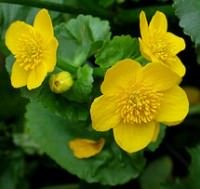
Buttercup multi-flowered (ranunculus polyanthemus) is stately (60-100 cm) beautiful plant straight pubescent stem and large (up to 3 cm in diameter) bright yellow flowers collected in inflorescences. The leaves of this species are long, wedge-shaped, and their petioles are also covered with fine hairs, like the stem. The multi-flowered ranunculus has a short flowering period - from June to July, it does not reproduce very actively, therefore it is less common in nature than the above-described counterparts. This ranunculus eschews civilization and can be seen in forest clearings and wide untouched meadows.
The use of buttercup multiflora in medicine
The stems, leaves and flowers of buttercup multiflora contain the alkaloid protoanemonin, as well as flavonoids, ascorbic acid and carotene.
Such a rich composition makes it possible to use this plant for the treatment of many diseases:
Furunculosis;
Rheumatism;
Purulent wounds;
Tuberculosis of the skin.
neuralgia;
migraines;
To prepare an infusion of buttercup multiflorum, you need to steam two teaspoons of fresh chopped raw materials with half a liter of boiling water and insist for forty minutes, and then strain thoroughly. Take the infusion 3-4 times a day before meals, one tablespoon.
Buttercup field
Field ranunculus (ranunculus arvensis) is a relatively low (up to 60 cm) plant with a vertical, highly branched, almost bare stem and wide dissected leaves. This species blooms with single golden-yellow flowers with a diameter of about one and a half centimeters. The rhizome of the plant consists of several small tubers, in which the content of alkaloids is higher than in the aerial part. The field ranunculus got its name precisely for the love of fields, meadows and pastures. He settles on open area and grows well even on acidic, loamy and calcareous soils.
The use of buttercup field in medicine
The field buttercup, like all others, tones, disinfects and anesthetizes well, but it also has two additional properties: antipyretic and laxative. Alcoholic tincture of buttercup field is used for rubbing with fever and warming compresses for sore throat, sciatica and osteochondrosis. A gruel of fresh leaves and stems eliminates warts and accelerates the maturation of abscesses. Buttercup tubers were not left without attention - food additives are obtained from them industrially.
marsh buttercup
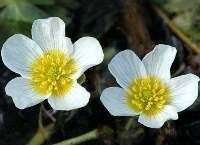
This type of buttercup is sometimes called water, following the literal translation. Latin name– ranunculus aquatica. This amazing plant it is not at all like its terrestrial counterparts - it takes root directly under water, sometimes at an impressive depth (up to two meters). Buttercup marsh has a thin bare stem and small (3-4 cm) leaves of light green color. The petiole of the leaves is about the same length as they are. The shape is also unusual - the leaves of the marsh buttercup are thin, pinnate, do not exceed 12 millimeters in width.
The water buttercup is the only species we have described that blooms not with yellow, but with white flowers peeping out of the water. The flowering period takes about five months and falls at the end of spring - the beginning of autumn, and ends with the maturation of a gray ovoid fruit with prickly bristles at the top. Buttercup marsh is found everywhere: in Europe, and in Asia, and in America, and even in Africa. It can comfortably settle down in any shallow pool of stagnant water or in a slowly flowing stream. On swampy, silty soils, this plant is also found, but much less frequently.
The use of marsh buttercup in medicine
In addition to the alkaloid protoanemonin, the stems and leaves of marsh buttercup contain saponins, so it is considered a powerful natural tonic and aphrodisiac. To prepare a decoction that stimulates sexual function, you need to pour a tablespoon of fresh chopped marsh buttercup with a glass of boiling water, boil for 3-5 minutes, then wrap and leave for one hour. The finished medicine is carefully filtered and taken in a tablespoon before meals three times a day. This infusion enhances sexual desire in both men and women.
In conclusion, I would like to say that all the types of ranunculus described by us are poisonous and have a similar chemical composition so they are interchangeable. The main thing is not to start treatment with buttercup without consulting a doctor, because you need to be careful with any poisonous plants!
Collection and preparation of buttercup
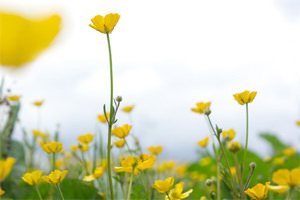
The optimal time for harvesting a buttercup is the end of the flowering period, when the fruits are just tied up, and the petals have not yet fallen from all the flowers. By this time, the concentration of nutrients in the aerial parts of plants reaches its climax. Buttercup roots are rarely used in medicine due to their extreme toxicity.
Collection of buttercups is carried out using a garden pruner or large sharp scissors. It is necessary to carefully cut the stems at a height of 5-10 cm above the ground to get the juiciest part of the plant. Tearing buttercups is not recommended for two reasons: firstly, you will stain your hands with poisonous juice, and secondly, damage root system, and then the plant will most likely die.
By the way, for greater safety, it is better to collect buttercups with gloves and tight clothing. When it comes into contact with the skin, and especially the mucous membranes, ranunculus juice causes severe irritation and burns, up to the formation of ulcers and blisters. The collected raw materials must be thoroughly washed and dried in the attic or under a canopy. Naturally, all these manipulations must be performed with gloves.
Buttercup should not be dried in direct sunlight, as most of the active ingredients, including protoanemonin, will completely evaporate from it.
When does buttercup bloom?
The periods of flowering in plants of this family vary greatly in duration, depending on the species. There are buttercups that bloom as early as April, and by June fruits with seeds already appear on them, and there are those that delight the eye with bright flowers from May to October, such as marsh buttercup. If you stumble upon a ranunculus and are planning to collect raw materials, try to identify the species with the help of scientific literature and photographs and, thus, recognize optimal time for workpiece.
How to store?
Fresh buttercup cannot be stored at all, useful substances quickly disappear from it, so it is necessary to start treatment immediately. But dried raw materials can be packaged in paper bags and hidden in a closet, where the buttercup will retain its medicinal properties for about one year.
Found a mistake in the text? Select it and a few more words, press Ctrl + Enter
The composition and properties of buttercup
All types of buttercup contain the following biologically active substances:
Protoanemonin is a volatile poisonous alkaloid with a sharp characteristic odor and a bitter burning taste. A small amount of protoanemonin has a healing effect on the human body: tones, stimulates work nervous system, increases immunity, kills microbes, increases the level of red blood cells and hemoglobin in the blood. And in large doses, it is the strongest plant poison with a nerve-paralytic effect, causing death from oppression of the respiratory center;
Coumarins are natural anticoagulants, which also accelerate the processes of cell regeneration, act as a source of vitamin P, prevent the growth of tumors and the formation of blood clots;
cardiac glycosides- substances that normalize cardiac activity, slow down the rhythm of contractions of the heart muscle, increasing systole and lengthening diastole, activating blood circulation and reducing;
Saponins - work as a choleretic agent, and also reduce temperature and pressure, dilute sputum and accelerate its removal from the bronchi, tone up and stimulate the reproductive system;
Tannins- narrow and strengthen the walls of blood vessels, create the thinnest protective film on the mucous membrane of the digestive tract after ingestion, and on the surface of the skin - with external application;
Alkaloids are a group of volatile toxic compounds that, in small doses, well stimulate the immune system, tone up, relieve fever, anesthetize, lower blood pressure, strengthen the walls of blood vessels, stop bleeding and disinfect wounds;
Flavonoids - substances that prevent the destruction of valuable hyaluronic acid in the human body, as well as stimulate metabolic processes, increase vascular elasticity, neutralize free radicals and prevent sclerotic lesions of the circulatory system;
Vitamin C is one of the most important vitamins for health, without which the normal functioning of the endocrine glands and the full absorption of iron from food is impossible. Ascorbic acid is also an antioxidant, cancer protector and important element to maintain the nervous system. Vitamin C deficiency has a detrimental effect on immunity and hematopoiesis;
Carotene is a substance necessary for good vision, strong bones and teeth, elastic skin and beautiful hair. The lack of carotene in the body turns into early aging, slowing down the synthesis of proteins, development and slowing down of the process of cellular regeneration;
Amino acids are the most important substances on which the quality of blood, the level of hemoglobin and the body's ability to cleanse depends. The more valuable amino acids a person receives, the faster he gets rid of harmful components of food and air - pesticides, radionuclides, heavy metals;
Vegetable oils- nourish and rejuvenate tissues, normalize metabolic processes, accelerate cellular regeneration, neutralize carcinogens and prevent the appearance of malignant neoplasms.
Thus, buttercup has many useful properties:
Tones;
Pain relief;
Reduces temperature and pressure;
Disinfects;
Relaxes;
Kills the fungus
Protects against cancer;
Normalizes metabolic processes;
Buttercup treatment
Conventional medicine treats buttercup with little interest, although it has been proven that this plant is one of the most effective means from tuberculosis of the skin. On pharmacy shelves, you will never find dried buttercup, which is sold on a par with chamomile, so if you want to try buttercup treatment, you will have to go to the nearest meadow to get raw materials on your own.
Doctors treat treatment with poisonous plants with understandable apprehension and skepticism, but this is not a reason to refuse a consultation. Buttercup has serious contraindications, in addition, it is very important to choose the right dosage and type of medicinal raw materials. Different parts of the plant have a different intensity of healing effect, so the advice of an experienced herbalist or naturopath will definitely not hurt you.
flowers
Buttercup flower infusions are used primarily to stimulate the nervous system and improve blood quality. This remedy also disinfects and kills the fungus well, so buttercup flowers are used to treat scabies, intestinal infections, Staphylococcus aureus and fungal skin lesions. From such raw materials you can make an excellent insecticide, with which you can easily clean the house of ticks, bedbugs and moths, or protect it from pests fruit crops in your garden.
If you grind freshly picked buttercup flowers into gruel, you get an analogue of mustard plaster and blister plaster. By applying this remedy to a boil or boil, you will accelerate the maturation and release of pus. Mustard plasters from buttercup flowers burn much stronger than usual, and you can keep them on your chest and back for no longer than fifteen minutes. Flowers can be rubbed on aching joints or back, then they will act as an anesthetic. And with malaria, as we mentioned above, crushed buttercup flowers are applied to the wrists and elbows to stop attacks.
Rhizomes and tubers
In the root system of the buttercup, the concentration of toxic alkaloids is very high, therefore, treatment with this part of the plant must be approached very carefully. Powder from fresh tubers or roots is used to remove warts and disinfect festering wounds. This raw material is also suitable for the preparation of alcohol tinctures against cancer, but an experienced herbalist who knows the exact dosage and understands the toxicity of the roots should do such things. different types buttercup.
There is an ancient folk method for treating infertility, according to which the roots of the buttercup must be cleaned and inserted into the vagina at night in the middle of the cycle to stimulate sexual function and ensure successful conception. But it is obvious that this barbaric method of treatment can cause not long-awaited motherhood, but a burn of the vaginal mucosa.
seeds
A decoction of buttercup seeds is used for colds as an expectorant and immune stimulant. In general, little is known about treatment with buttercup seeds, and the most likely reason for the paucity of information is that they are difficult to collect in sufficient quantities, and there is no need to do this when there are flowers, leaves and stems that have the same properties.
Leaves and stems
The herbaceous part is the most popular type of raw material for ranunculus treatment. It is from fresh and dried leaves and stems that decoctions and infusions are most often prepared against ulcers and boils, headaches and colds and skin infections. Freshly squeezed ranunculus juice copes well with warts, fungal infections and scabies.
If you have suffered a joint or soft tissue injury, hurry to apply crushed buttercup leaves to this place - this way you will avoid severe swelling and internal hemorrhage, and also relieve pain. A slurry of buttercup leaves and stems prevents the formation of an ugly bruise at the site of a bruise, if applied immediately and held for 15 minutes.
IN folk medicine since ancient times, a mixture of table vinegar and crushed buttercup leaves has been used. This healing remedy helps with, and if regularly rubbed into the affected skin. But do not forget to wash off the drug after 10-15 minutes.
Infusion, tincture, ointment and ranunculus juice

Oriental healers, Russian healers and northern shamans prepare medicines from buttercup. It is safe to say that this medicinal plant has long been carefully studied. Buttercup treatment is relevant for skin inflammation, pain syndrome of various etiologies, neuralgia and joint damage, colds and oncology. The main thing is to choose the right dosage form.
water infusion
The most commonly used form is an aqueous infusion, since it is technically incorrect to make a ranunculus decoction, because when boiled, most biologically evaporate from it. active substances. You can boil the buttercup for a maximum of five minutes, but it’s better to just steam it with boiling water, wrap it up and insist. The infusion time should not be too long, it is optimal to keep the raw material in the medicine for 30-60 minutes, and then carefully filter it, since too many toxic alkaloids will pass into it over a longer period.
We will not give the recipe here. alcohol tincture for the treatment of cancer, as it is a dangerous and complex technique that requires a lot of experience and precision. But the external use of ranunculus tincture is quite safe and useful for many diseases.
Take 50 fresh ranunculus flowers, pour half a liter of medical alcohol, tightly seal the glass container and keep the medicine in a dark cool place for 21 days, shaking occasionally. Then filter and use for warm compresses, rubbing and disinfecting wounds.
Healing ointment
To prepare an ointment, take fresh flowers buttercup, grind them and mix with lard (pork fat) in a ratio of one to four. It is necessary to store buttercup ointment in the refrigerator in a tightly closed glass jar.
This is an excellent remedy for colds - it is enough to rub buttercup ointment on your chest and back and wrap yourself in a warm scarf to calm and sleep peacefully all night long. You can apply such an ointment to a sore throat, and to inflamed lymph nodes, and to muscles that are chilled by a draft, but be sure to wrap the sore spot to enhance its healing effect.
Juice
Freshly squeezed buttercup juice allows you to remove warts, as well as relieve excruciating toothache, if the cotton wool soaked in it is briefly applied to the gum. Cataracts at an early stage are treated with highly diluted buttercup juice: for this you need to wipe sore eyes 3-4 times a day.
Fresh ranunculus juice is a very caustic substance that, with prolonged contact, causes burns of the skin or mucous membranes, ulceration or even necrosis of the epidermis.
Precautions in the treatment of ranunculus

Do not forget that buttercup is very poisonous plant Therefore, they can be treated only after consulting a doctor. It is also important to follow the dosage exactly, since a substance that is beneficial in a small amount can cause irreparable harm in a large amount.
The symptoms of ranunculus poisoning are as follows:
Sharp pain in the epigastrium;
Liquid stool;
Slow or fluctuating heart rate;
Profuse salivation;
If there is a suspicion of ranunculus poisoning, you need to follow simple steps as soon as possible:
Call an ambulance;
Rinse the stomach with a weak solution of potassium permanganate;
Drink activated charcoal at the rate of 1 tablet for every 10 kg of weight.
Severe poisoning is caused by protoanemonin, a poisonous volatile alkaloid contained in buttercup. The danger is not only the ingestion of a large dose of this alkaloid into the body, but also prolonged exposure to the skin and mucous membranes. Injections of ranunculus extract threaten tissue destruction and necrosis, so they are not currently being made. Only the methods described above are relevant, and only the named dosages, which must be strictly followed.
Contraindications to the use of buttercup
Buttercup treatment is contraindicated for pregnant and lactating women, as well as people with individual intolerance to the biologically active ingredients of the plant.
Buttercup poisoning
Livestock grazing in floodplain meadows are at risk of ranunculus poisoning. If the animal eats a lot of poisonous grass, it will lose the ability to chew food, will experience great anxiety and excruciating pain in the abdomen. You can guess about poisoning by salivation, vomiting and.
In severe cases, the animal begins to convulse half an hour after eating the buttercup, it falls to the ground, its eyes roll, breathing stops, and then the victim loses consciousness and dies. To protect your livestock from such a fate, you need to carefully inspect the pasture for the presence of poisonous plants (buttercup,) before driving out to graze.
Recipes for buttercup treatment
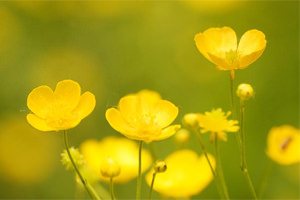
Decoction of heel spurs. Pour a glass of fresh herbs into a three-liter saucepan hot water, boil for several minutes, cool slightly, pour into a basin and steam your legs until the broth has completely cooled down.
Infusion for tuberculosis of the skin. Pour three tablespoons of crushed ranunculus leaves with two glasses of boiling water and insist for three hours, then strain and make lotions and compresses with cotton wool and warm infusion.
Tincture for umbilical hernia. Pour half a glass of buttercup flowers with half a liter of vodka and insist in a dark, cool place for three days, then strain and take one tablespoon before meals three times a day for a month.
Tincture for rheumatism and gout. For half a glass of vodka, you will need 10 grams of fresh buttercup flowers. The tincture should be kept in a dark place for a month, and then strained and used for rubbing and compresses.
A decoction for hepatitis and liver failure. Steam a teaspoon of fresh crushed buttercup stems and leaves with a glass of boiling water, soak for 15 minutes in a water bath, then carefully strain and take one and a half teaspoons three times a day before meals for at least two months to achieve a lasting therapeutic effect.
Acetic tincture for pancreatitis. Mix in a glass jar half a cup of fresh ranunculus herb and two and a half cups of table (9%) vinegar. Soak the tincture for a day, then carefully strain and dilute with water in a ratio of 1:10. At each attack of pain, take the medicine, starting with one drop and doubling the dosage every half hour until you reach thirty-two drops. You can resort to such treatment only after consulting a doctor.
Author of the article: Sokolova Nina Vladimirovna, naturopath, phytotherapist
Buttercup creeping gives a lot of trouble to gardeners with its ability to form new plants. At the same time, it is widely used in folk medicine due to its medicinal properties.
Appearance
This perennial herbaceous plant belongs to the buttercup family, which has about 600 species. The rhizome is short (no more than 2 cm) and branched. Stem creeping or ascending, thick and succulent, may be glabrous or covered with erect hairs. Buttercup creeping does not belong to tall plants, its height rarely exceeds 40 cm.
Basal leaves are a rounded heart-shaped plate on an elongated petiole. Almost to the very base, they are dissected into 5 segments, cut into sharp three-toothed lobes. The upper leaves are sessile, also divided into segments. The leaves are covered with adpressed hairs on both sides and have inside paler color.
Flowers are usually very numerous, located on long peduncles, their diameter can be from 2 to 3 cm. Each flower consists of five bright yellow petals and numerous pistils and stamens. Buttercup blooms from early June until late autumn. Then a fruit is formed on it - a combined achene. After shedding, the seeds germinate very slowly, they germinate best after wintering. Buttercup creeping, the photo of which is posted in this article, has a very interesting feature- he throws forward the stalk, which in suitable place takes root, forms a rosette and goes on. Its spread rate is quite high. Behind a short time Buttercup turns out to cover a rather large area, if no measures are taken against it.
Places of growth
This flower grows almost everywhere. It can be found in Europe, Western Siberia, the Caucasus, Asia and Africa. Favorite places for him are shaded areas located along the banks of lakes, rivers, wet meadows, forest swamps, fields. Ranunculus prefers mainly nutrient-rich heavy soils and peat bogs. 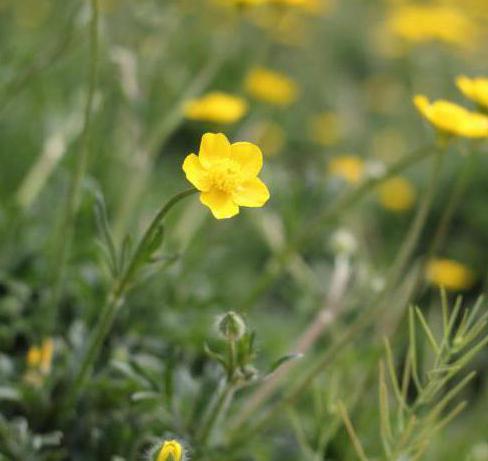
Poison properties
Buttercup creeping, the description of which is given above, belongs to the category of poisonous plants. And so are all its parts. This is due to their high content esters, protoanemonin, ranunculin and flavonoids. These substances can have a damaging effect on the heart, digestive organs and kidneys, excite the nervous system.
Avoid getting the juice of the plant inside - this can cause a burning sensation in the mouth and stomach. As a result, vomiting, excessive salivation and abdominal pain appear. Sometimes, in especially severe cases, ranunculus poisoning leads to convulsions and loss of consciousness. Even getting juice on the skin often leads to a burn.
Application in traditional medicine
As a medicine, buttercup creeping is used with long time ago. In folk medicine, there are many different recipes when the use of this plant helps to cure certain diseases. The substances that make up the buttercup, which have an irritating effect when applied topically, in small doses can increase the number of red blood cells in the blood, stimulate the activity of the nervous system, have an antimicrobial effect, ridding the body of pathogens of staphylococcus and E. coli.

The bactericidal, wound healing and analgesic effect of buttercup has long been used to treat gout, rheumatism, sciatica and arthritis. Creeping ranunculus is very effective against skin diseases. Gruel prepared from the leaves of this plant is successfully treated fungal diseases skin, scabies and remove warts. Powdered leaves and flowers were used in the old days instead of mustard plasters, and also applied to abscesses and boils, which accelerated their maturation.
When using buttercup as a medicine, one should not forget that this is a poisonous plant, and therefore it is necessary to avoid getting its juice on wounds, scratches and cuts.
Collection and preparation
All parts of the plant except the root have medicinal properties. Raw materials are harvested during the entire flowering period of buttercup. In this case, you must take precautions and be sure to use gloves. The stem is very carefully plucked or cut with scissors so as not to damage the root. The collected grass is recommended to be washed and laid out in the shade to dry. In no case should you dry it in the sun, otherwise there will be no trace of all the beneficial properties that creeping buttercup has. Its use for therapeutic purposes will be completely ineffective. 
It is best to dry the flowers and leaves of the plant as a whole, without cutting it into pieces, because in the future they may be needed in this form. You can cut them down at any time.
Recipes
All home remedies made from buttercup are recommended for external use only. It is unacceptable to use them inside.
Infusion for compresses and lotions: Pour 3 tablespoons of herbs with two cups of boiling water and leave for 3 hours to infuse in a warm place.
A decoction for the treatment of skin diseases: brew the herb with boiling water, simmer for 10 minutes over low heat.
Buttercup is a delicate herbaceous plant with surprisingly beautiful flowers. Particularly interesting garden molds with large spherical heads. The plant belongs to the Ranunculaceae family. The genus is represented not only decorative species, but also weeds with caustic and poisonous juice. Buttercups are common in temperate and cold climates throughout the Northern Hemisphere. They live in open meadows and fresh water. The scientific name for buttercup, ranunculus, comes from the word for frog. It is given for the ability to grow where amphibians live.
What does buttercup look like
Buttercup is a perennial or annual with straight, branched shoots up to 20-100 cm high. It has a fibrous root system, on the processes of which palmate, spider-like tubers are formed. On a thickened ribbed stem is another foliage with whole serrated or dissected plates. It has a bluish-green or dark green color. The leaves do not differ in large sizes, usually the length does not exceed 6 cm.
In June-July, on the tops of the stems bloom beautiful flowers. They can be simple or double, similar to flowers of roses and peonies. The number of flower elements is a multiple of 5 (rarely 3). The diameter of the corolla depends on the variety and can be 2-10 cm. The color of the flowers is very diverse (solid or variegated): bright salmon, purple, yellow, orange, cream, white. In the center are many short stamens and pistils. The flowering period lasts about a month. Cut flowers will last at least a week in a vase.
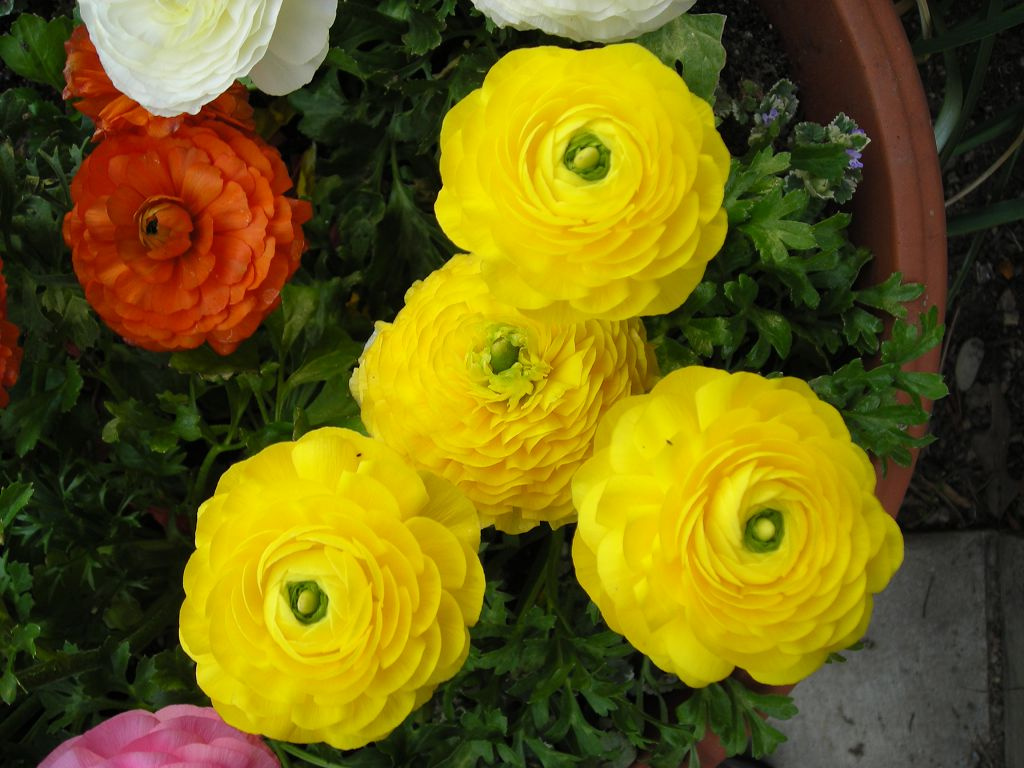

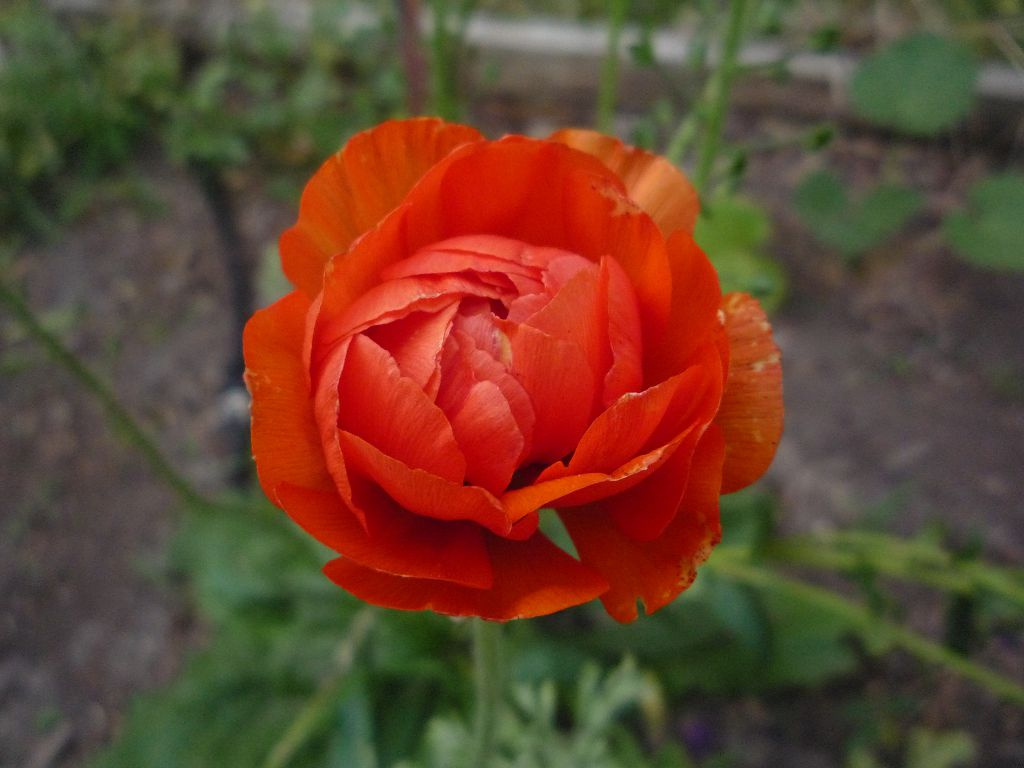
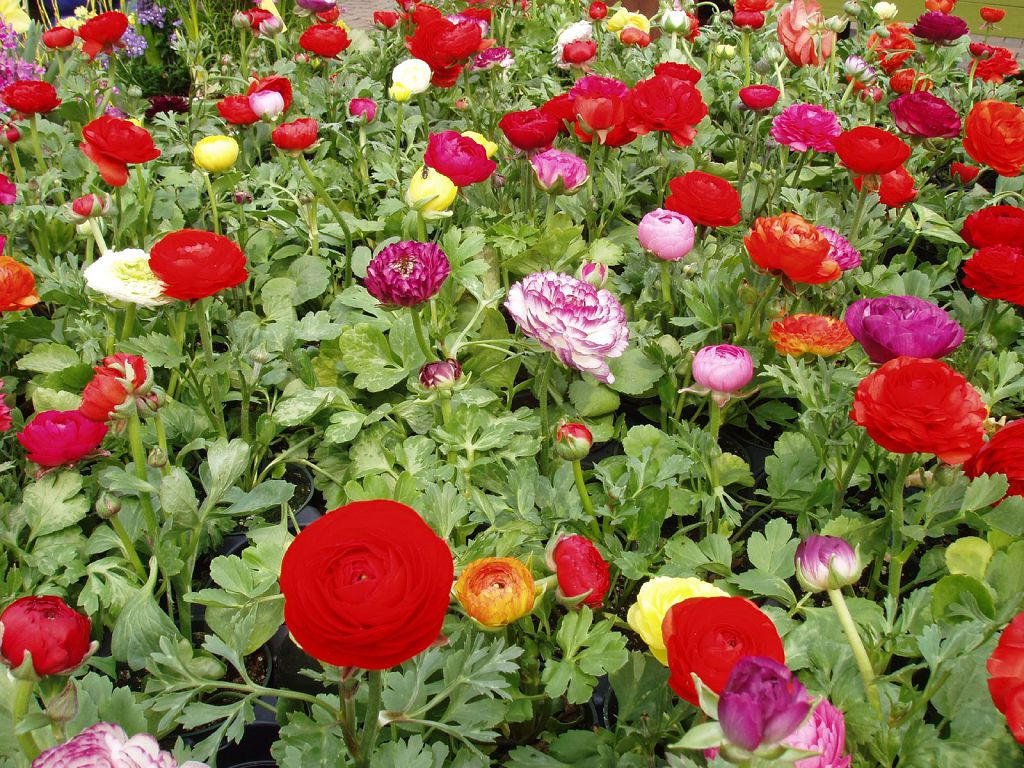

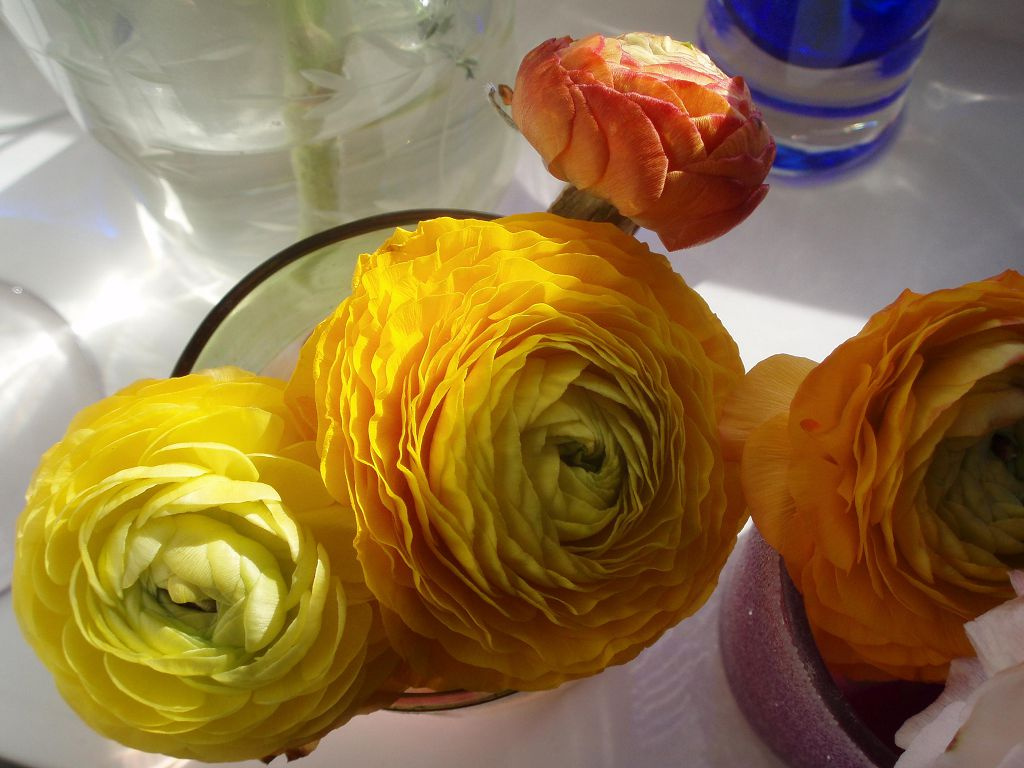
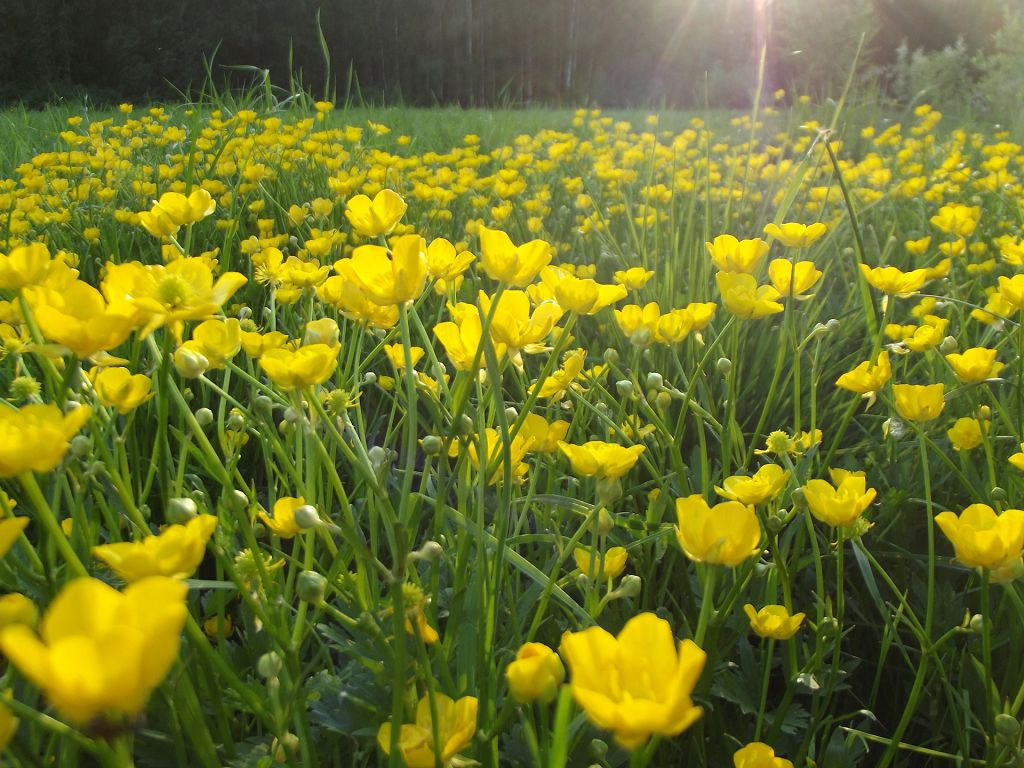
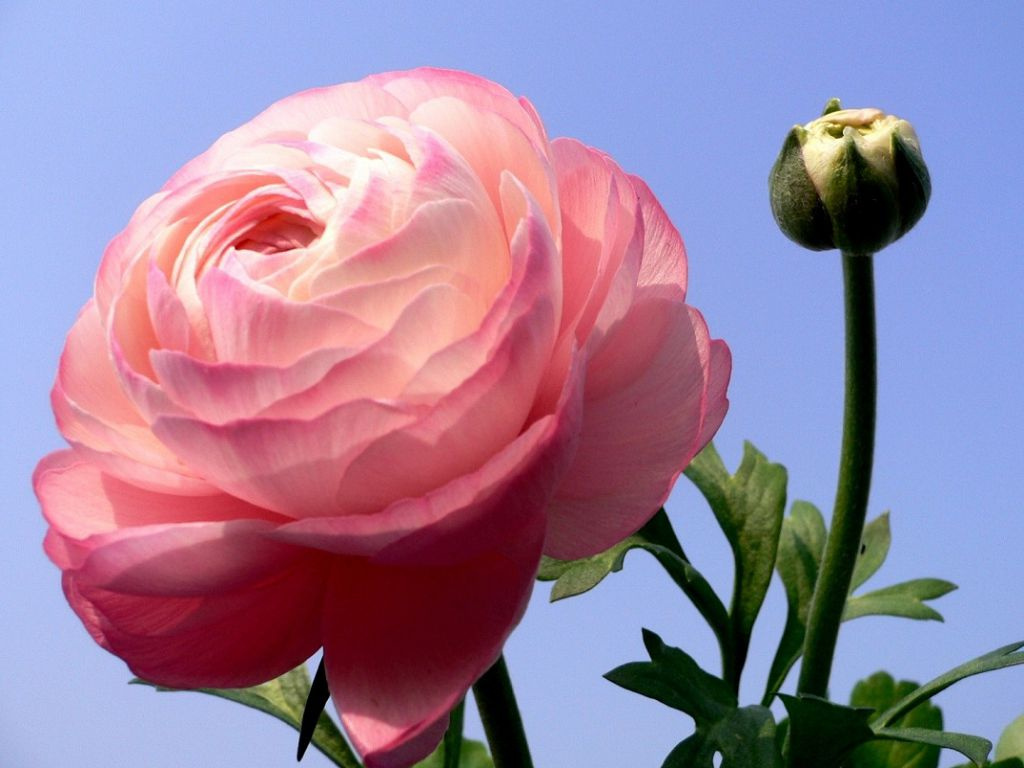
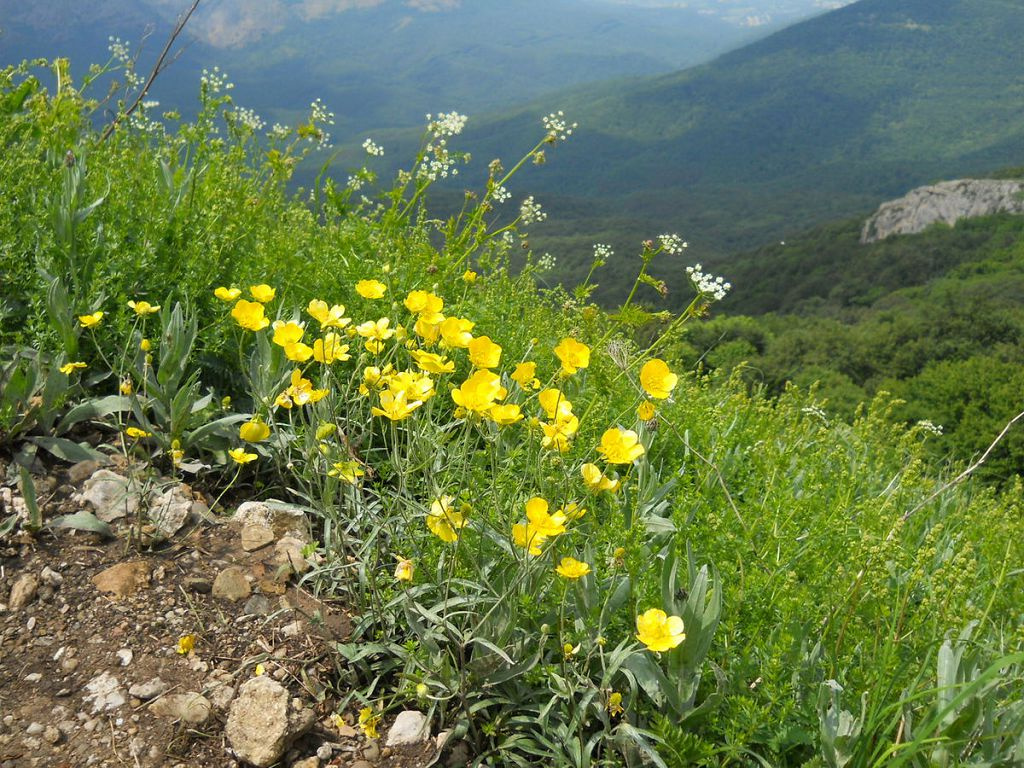


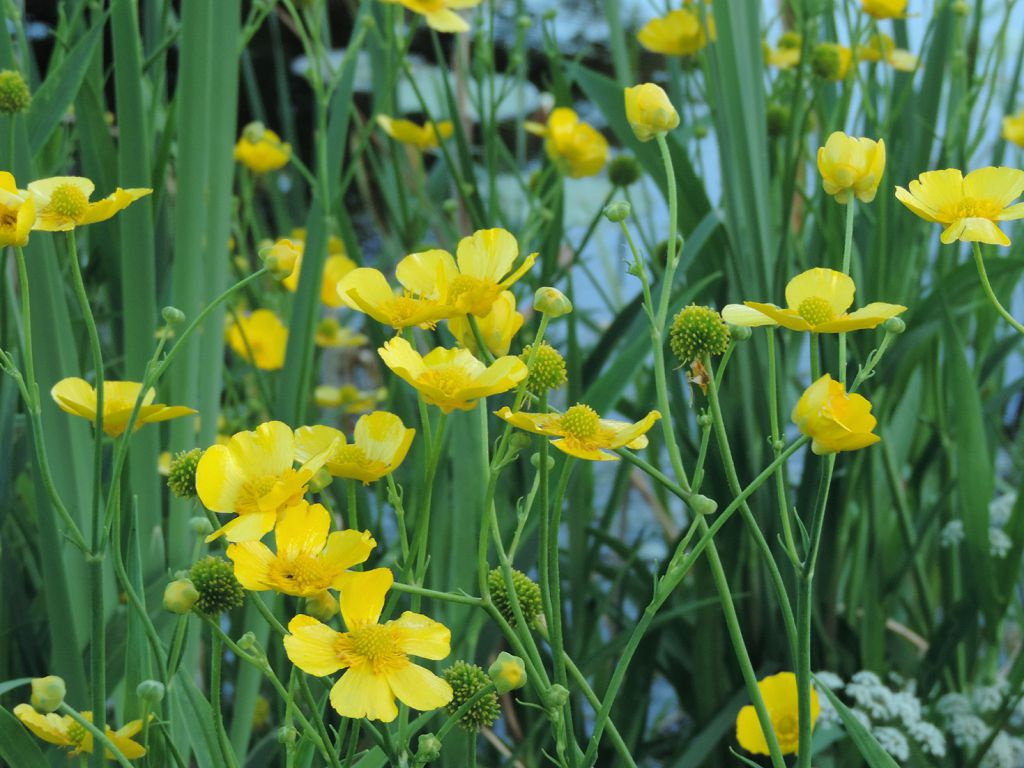

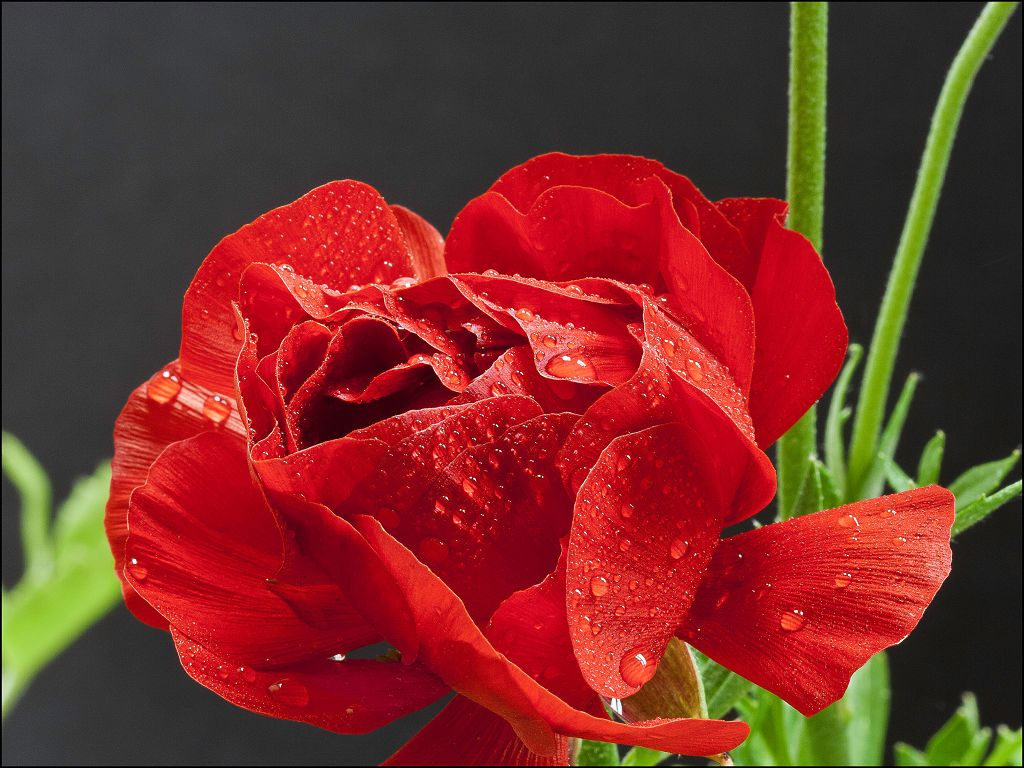
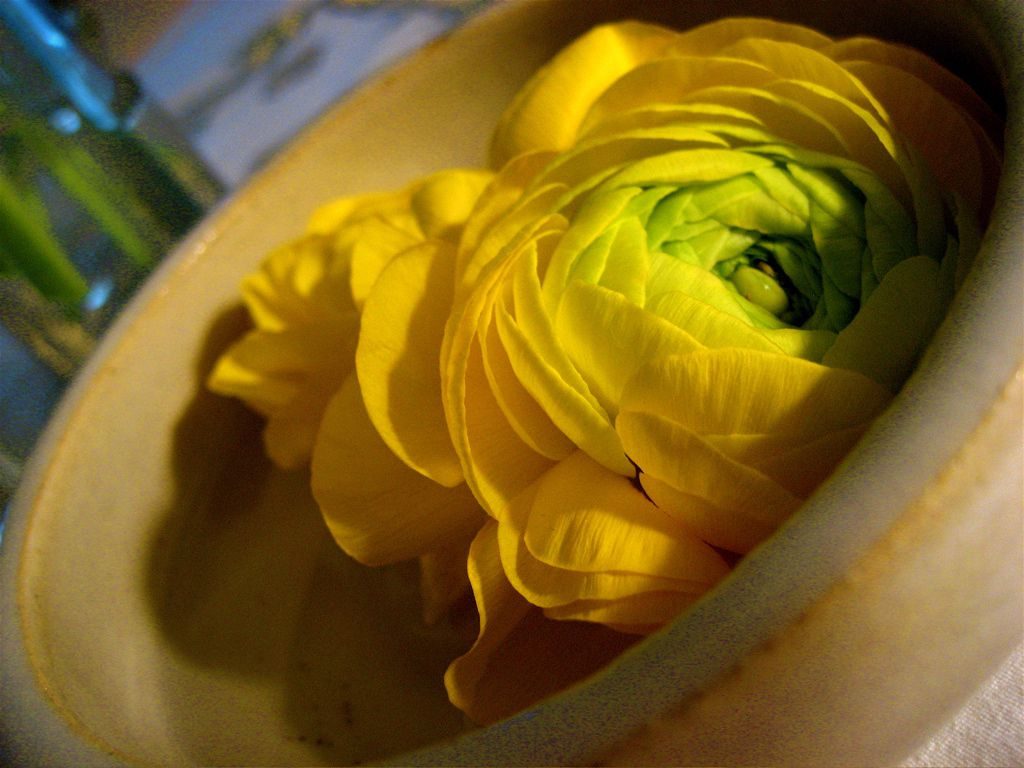
After pollination by insects, complex fruits are formed - multi-nuts. When ripe, they burst on their own, releasing fleecy convex seeds. There are several dozen of them in each fruit.
Attention! Buttercup juice is poisonous. Its name comes from the word "fierce", capable of destroying an animal and a person. It can cause skin irritation and poisoning, so all work is carried out with gloves, and animals and children are not allowed near the flowers.
classic views
Already today, more than 400 plant species are included in the genus of buttercup, and the list continues to grow.
Buttercup caustic (night blindness). Herbaceous perennial with a height of 20-50 cm consists of erect, branched stems. Foliage is located along the entire height of the shoots, but quite rarely. Below it is larger, almost whole. The upper leaflets are strongly dissected, with linear lobes. In June, simple yellow flowers with 5 wide petals appear. In diameter, they do not exceed 2 cm.
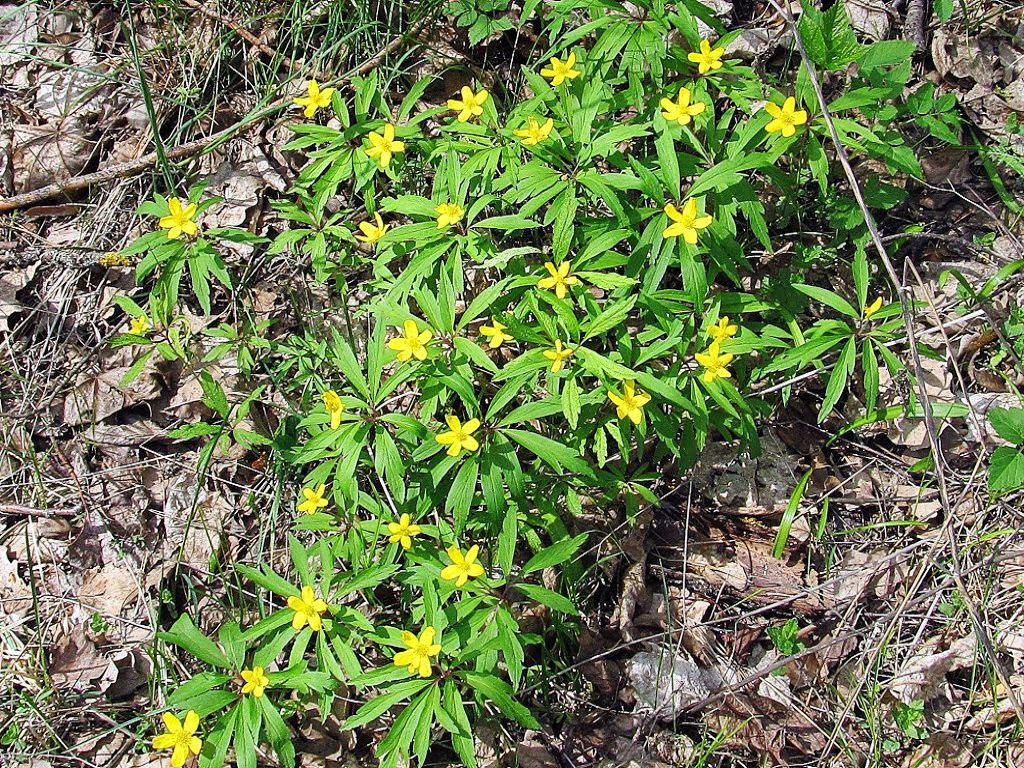
Buttercup golden (yellow). An inhabitant of damp shady meadows grows 40 cm in height. There are almost no leaves on a straight stem. The basal rosette consists of rounded toothed leaves on long petioles. At the top is a linear sessile foliage. Small yellow flowers have a pubescent calyx and a simple bell-shaped corolla. They bloom in April-June.
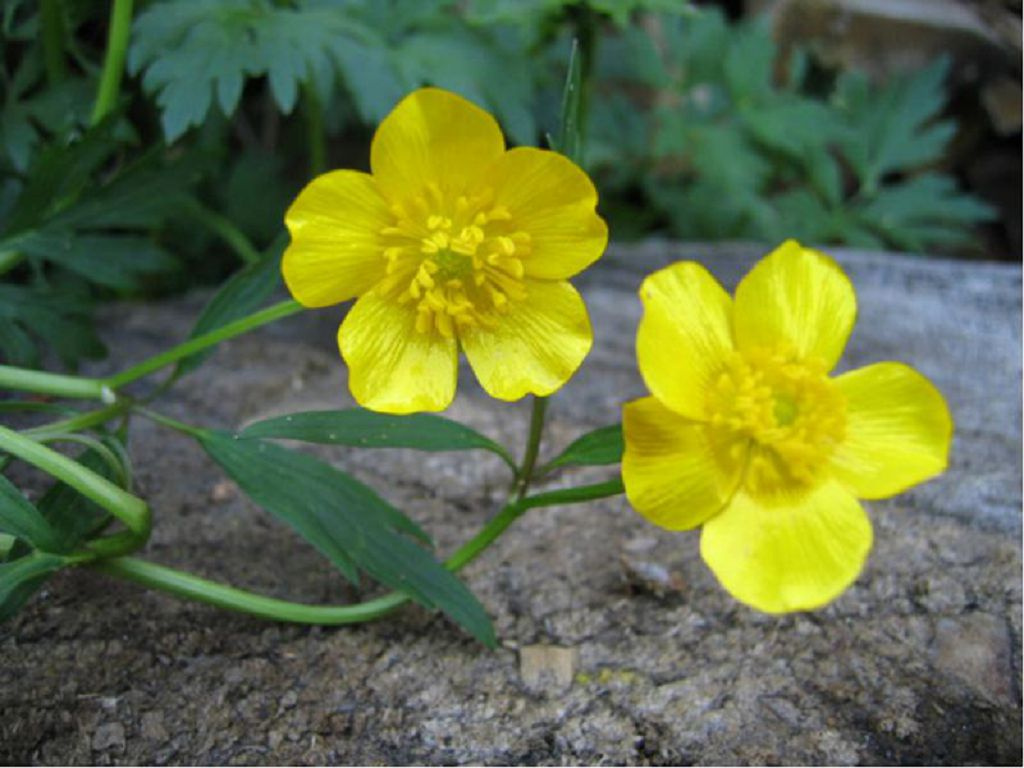
A perennial plant with decumbent shoots 15-40 cm tall, it easily takes root at the nodes upon contact with the soil. The stem is covered with a short pile. Petiolate bright green foliage grows along the entire length. Regular simple yellow flowers consist of 5 petals. They open at the beginning of summer.
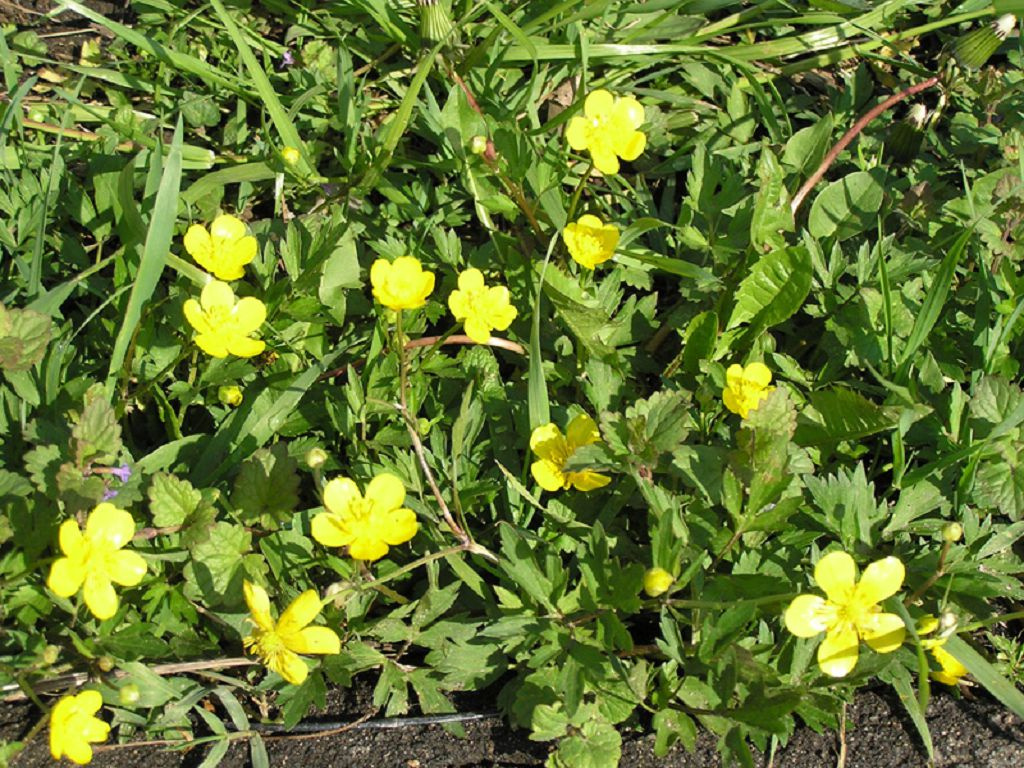
Underage or annual plant with an upright branched stem grows 10-70 cm in height. On the shoots are openwork trifoliate leaves with serrated sides. The ovoid broad lobes are dark green. In May-June, small umbellate inflorescences with small (7-10 mm wide) light yellow flowers appear on the tops of the shoots.
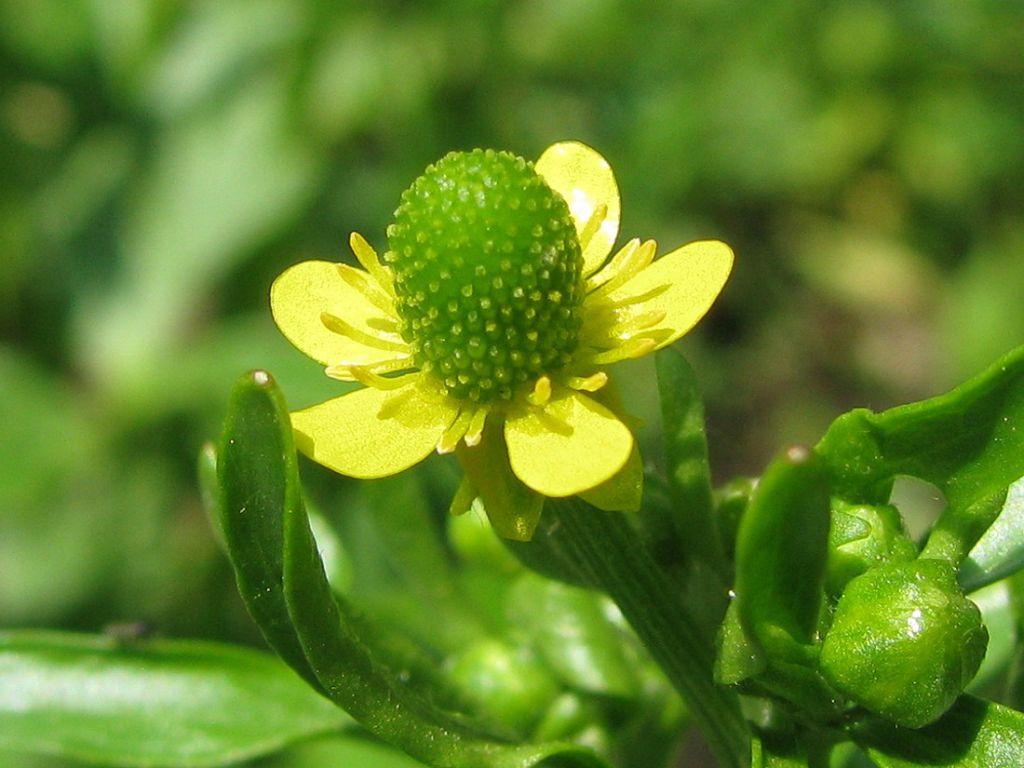
Buttercup Asian (asiaticus). Perennial with a branched erect stem up to 45 cm in height grows bright green pubescent leaves. In July, flowers bloom, located singly or 2-4 pieces in an inflorescence. They have a variety of colors and grow 4-6 cm in diameter.
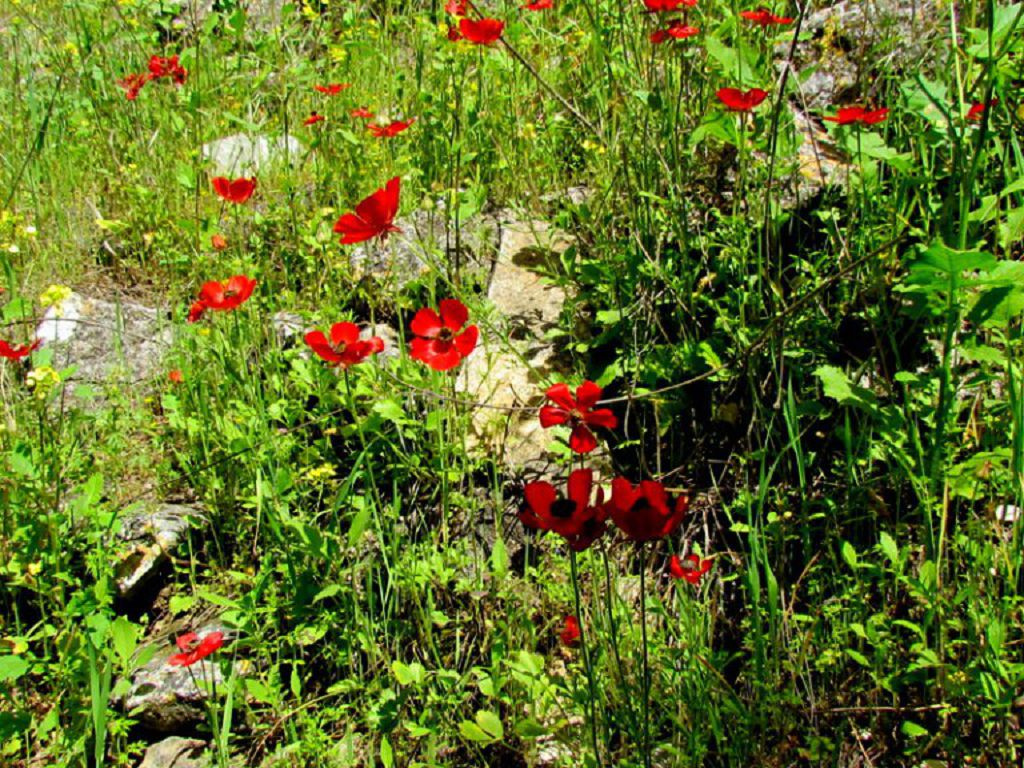
A perennial plant with a bare ascending or erect stem grows 20-50 cm in height. The foliage has a diamond-shaped or oval shape. The lower leaves are attached with long petioles, and the upper ones sit on the stem. Small flowers (0.8-1.2 cm) grow singly and are yellow. The sap of the plant is poisonous and irritates the skin.
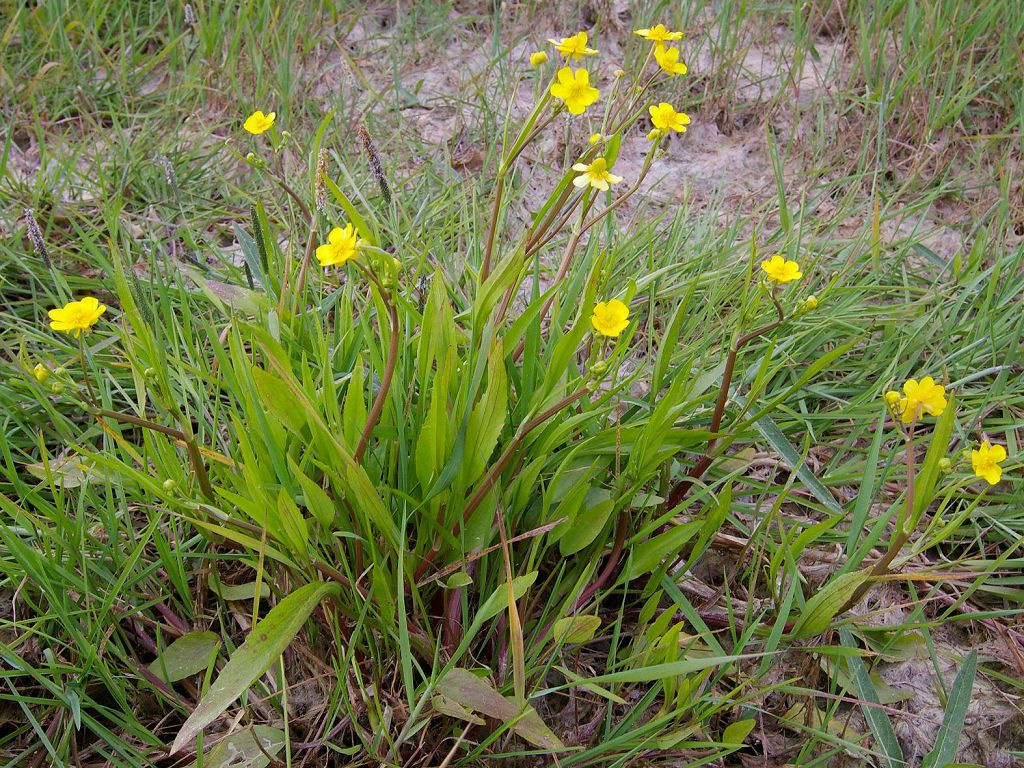
The inhabitant of swampy reservoirs of Australia due to creeping shoots is very modest in size. Its height is about 5-20 cm. On straight petioles, carved leaves look like green snowflakes. The plant looks quite decorative and is often used in the aquarium hobby.
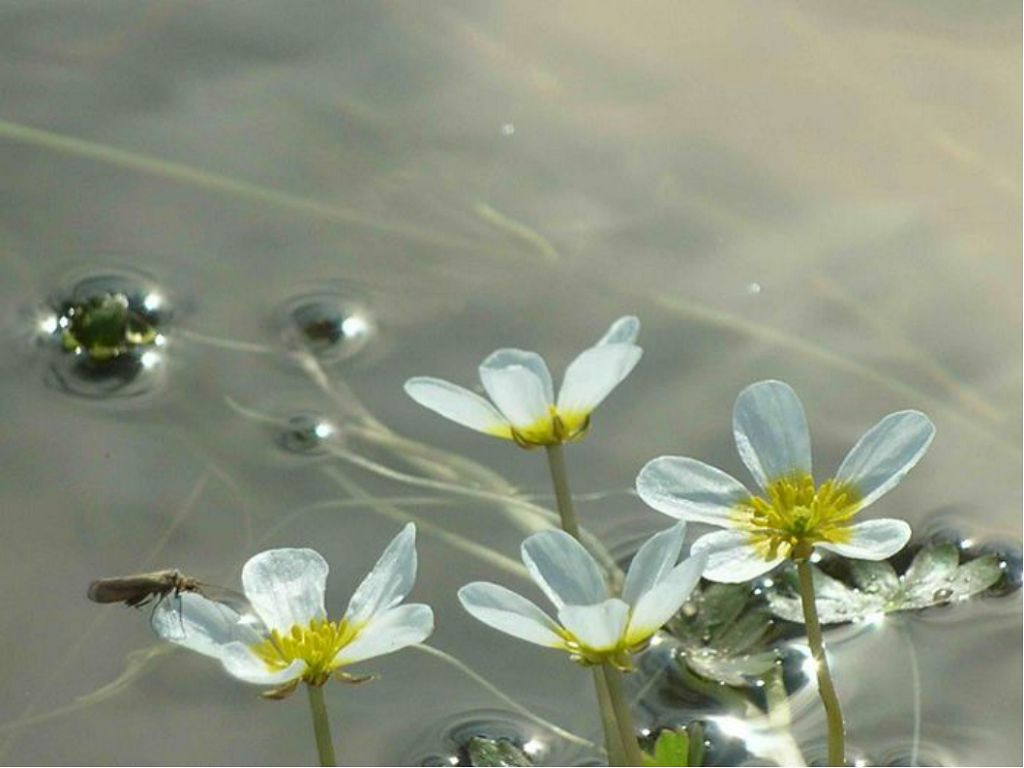
Herbaceous perennial 40-80 cm in height consists of erect, branched stems with a short pile. The palmately dissected foliage is also pubescent. It has elongated lanceolate lobes with incised edges. Simple bright yellow flowers adorn the plant from June to August.
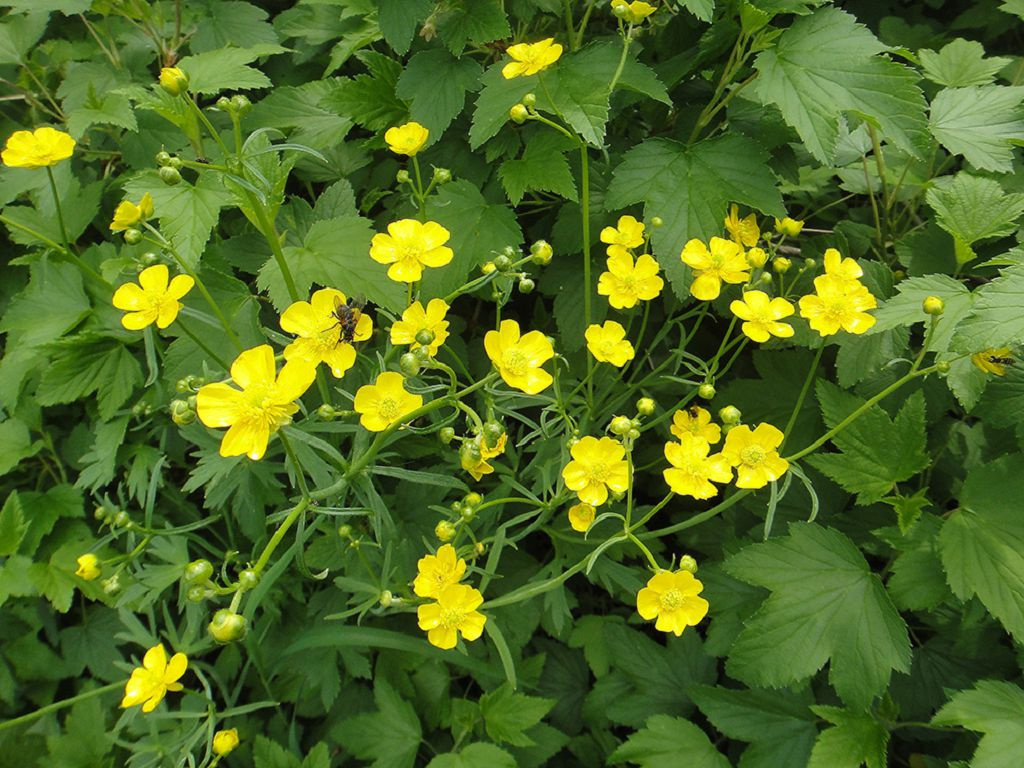
A flowering plant with curved stems 20-30 cm high grows round or heart-shaped leaves 2-3 cm in diameter. The lower ones are located on long petioles, the upper ones are sessile. In early summer, solitary yellow flowers with a hairy receptacle appear.
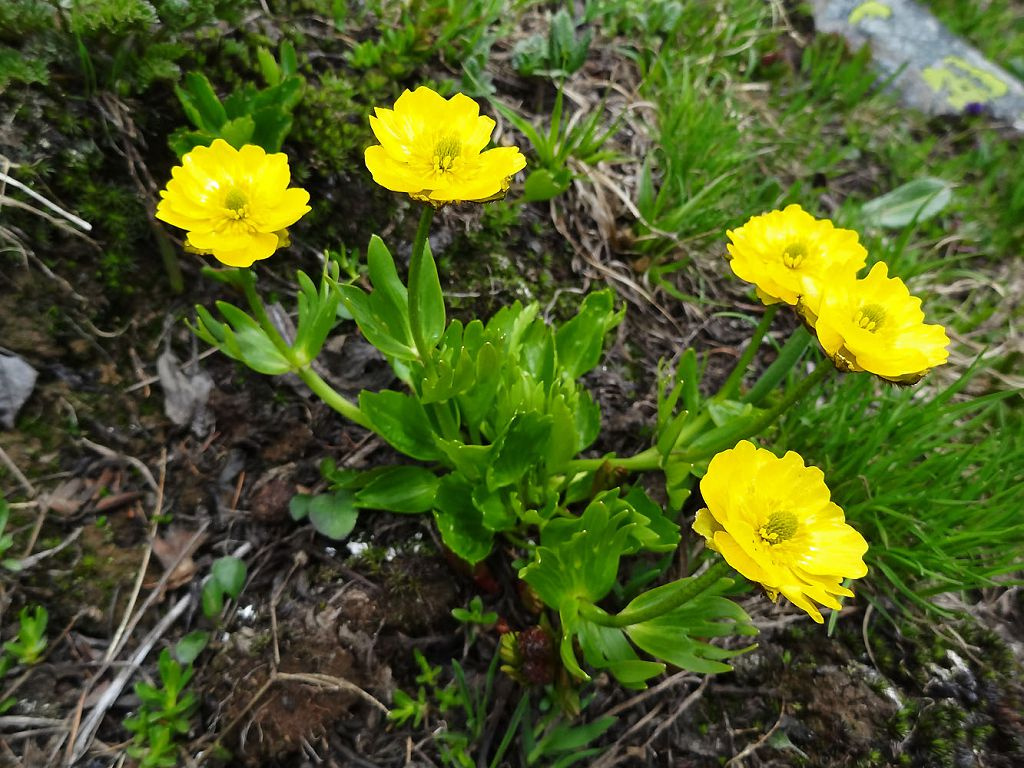
A perennial plant with a straight stem, branched only in the upper part, 30-60 cm high. whole leaves rounded or heart-shaped, located on petioles at the base of the shoot. The upper leaves are palmately dissected, small. Single flowers of a light yellow shade in diameter are 2-3 cm. They bloom in April.
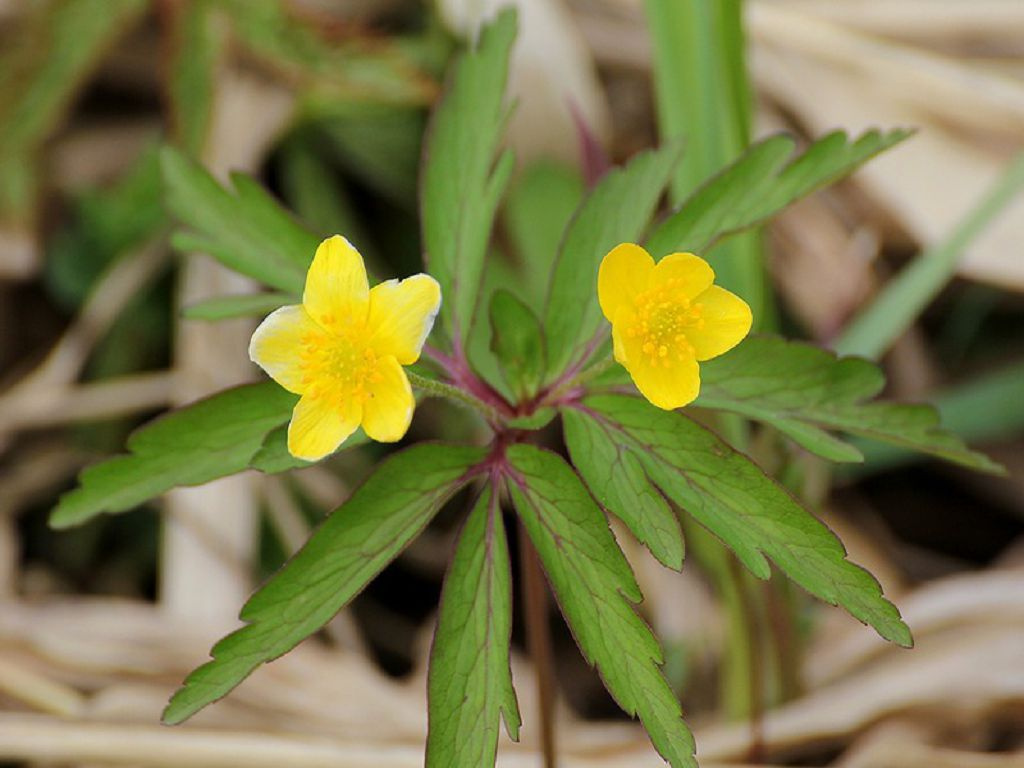
Decorative garden ranunculus
This group of plants is highly decorative and is most common among gardeners. The most interesting varieties:
- Buttercup Masha. A compact plant with a branched stem up to 30-40 cm in height blooms double flowers with white petals and a bright border.
- Buttercup terry (peony). Large plain flowers with closely spaced petals.
- French. Semi-double flowers consist of 2-3 rows of wide petals.
- Persian. Small single or semi-double flowers.
- Chalmoid. It blooms with dense, spherical flowers.
Reproduction methods
Buttercup is propagated by seeds and division of the rhizome. Since most ornamental buttercups do not pass on varietal properties to offspring, purchased seeds are needed for sowing.

Seedlings are pre-grown. To do this, already in the second half of February, seeds are sown in boxes with sandy-peat or loose garden soil and sprinkled with a thin layer of earth. They are carefully watered and covered with a transparent material. The greenhouse is kept in a bright place with a temperature of + 10 ... + 12 ° C. Shoots appear quite amicably in 15-20 days. From this moment, the shelter is removed and the pot is transferred to a warmer (+ 20 ° C) room. Lighting should be diffused, but quite intense. Phytolamps are used if necessary. When 4-5 leaves appear on the seedlings, it is dived into separate peat pots.
Every year, new tuberous growths form on the roots. When dug up in September, they are separated. In a frosty winter, the roots do not survive on the street. A cool room is more suitable for them (+ 19 ... + 21 ° C). In the spring, cones are planted in a flower bed.
Planting and care in the open field
Buttercups are planted in the garden at the end of May, when the likelihood of frost will finally disappear. Pick up sunny or slightly darkened areas with good draft protection. Constant exposure to direct sunlight is undesirable, as flowering will be short-lived and less abundant.
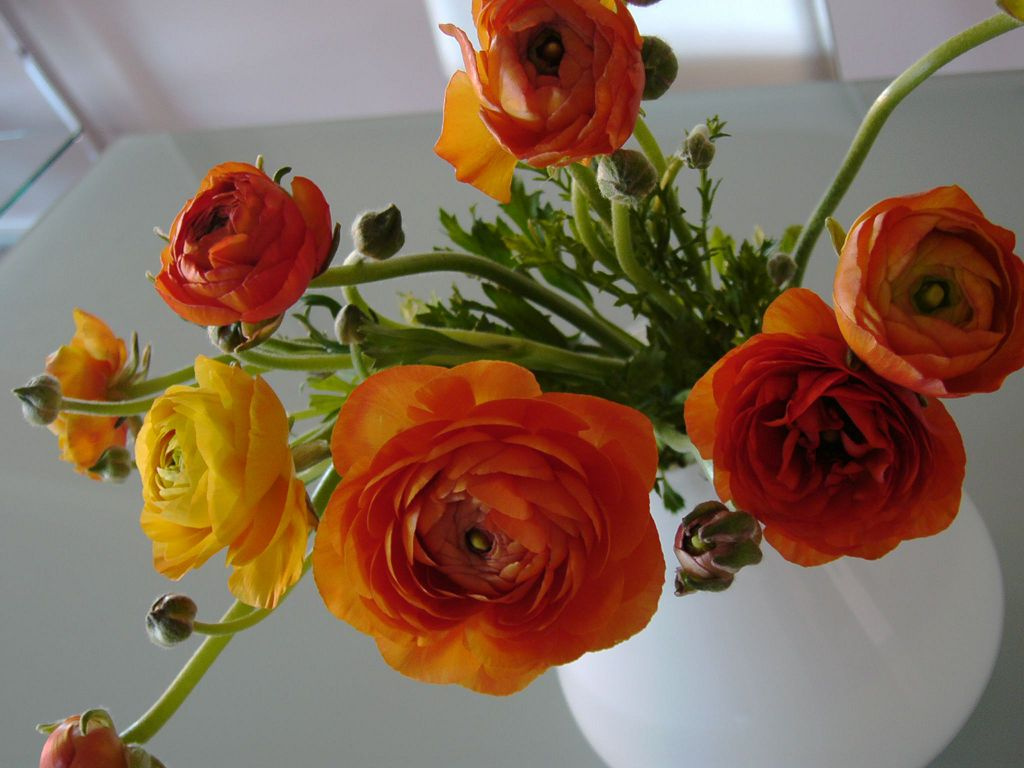
The soil should be neutral or slightly acidic. close occurrence ground water contraindicated. It is best to choose fairly loose, nutritious soils with moderate moisture. The site is dug up in advance and pits are prepared to the depth of the root system. The distance between plants is 15-20 cm. A little sand or vermiculite is poured into the bottom of each hole. Planting is best done with a pot or a large clod of earth flush with the root collar.
Nodules are pre-soaked for 12 hours in warm water with potassium permanganate and growth stimulator. They are planted to a depth of 8-10 cm. The soil is compacted and watered abundantly.
Further care of the plant is not very burdensome. Periodically, weed the beds, remove weeds and break the crust on the surface of the earth.
Watering should be moderate. Only in the absence of precipitation, the flower bed is watered twice a week. From August, plants need to be watered much less frequently so that the tubers ripen and do not rot. In case of prolonged rainy weather, the plantings are covered with a film.
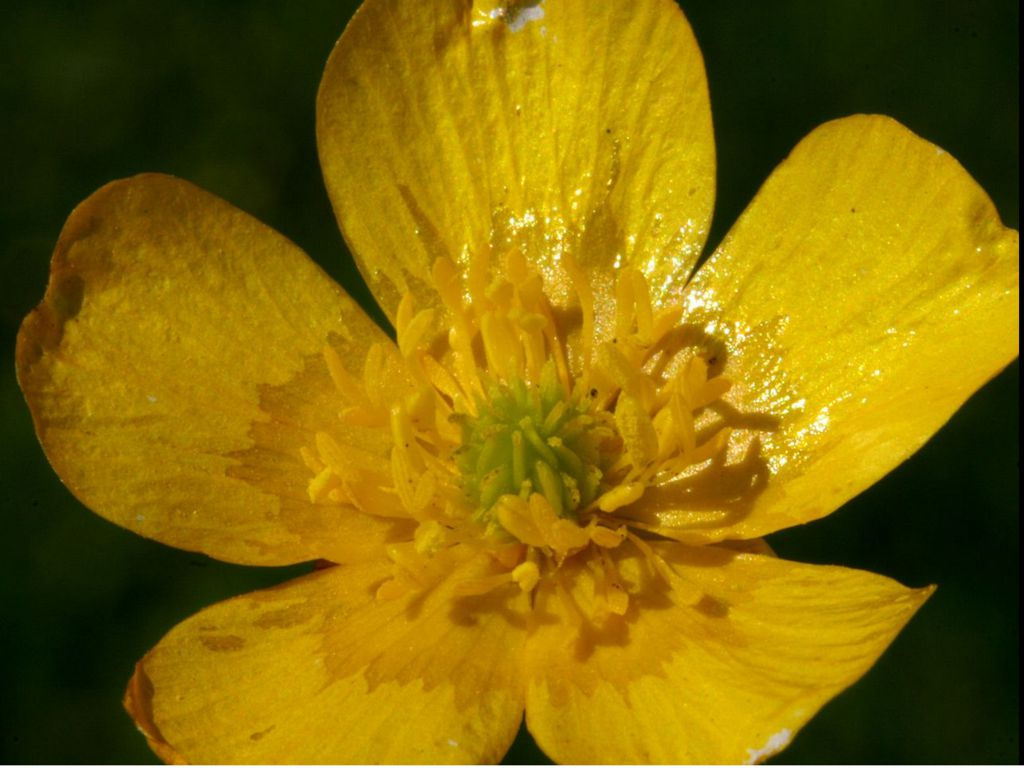
Every 15-20 days the buttercup is fed with mineral complexes. At the beginning of growth, nitrogenous compounds are used, and with the advent of buds, they switch to potassium-phosphorus.
To make the flower bed look neat, wilted flowers should be cut immediately.
Buttercups are quite heat-loving plants, so winter in open field They can not. In autumn, when the entire ground part begins to dry out, the tubers are dug up. They are dried in a ventilated place and stored in cloth or cake pots.
Buttercup is sick infrequently, mainly with fungal infections that develop with regular flooding of the soil. The first signal is the dropping of even unblown buds and flowers. Also, brown or whitish plaques may appear on the leaves and stems. If a disease is detected, it is necessary to temporarily stop watering and treat with a fungicide.

Beneficial features
Although buttercup is considered a poisonous plant, in small quantities it can have a positive effect on the body. It is used in folk and official medicine. The juice contains saponins, fatty oils, tannins, glycosides, ascorbic acid. Taking drugs inside stimulates the production of hemoglobin and stabilizes the nervous system. Outwardly, fresh leaves and lotions with decoctions and water infusions are used. They help fight joint diseases, gout, lupus, scabies, calluses.
It is very important not to exceed the dosage, so it is better to use pharmaceutical products rather than self-prepared ones. Also, buttercup treatment is contraindicated in pregnant and lactating women, as well as people prone to allergies.
Use in the garden
Garden terry or simple buttercups with large, bright flowers will become wonderful decoration mixed flower bed. Depending on the height, they are used in the foreground or central plan of the flower garden, as well as in rockeries, alpine slide or mixborder. Some species are successfully cultivated in pots, such as houseplants. In the flower garden, buttercup is usually combined with bluebells, cornflowers, hostas, evergreen shrubs.
An annual or perennial creeping plant, buttercup, belongs to the buttercup family, popularly called night blindness or fierce color.
Description
In height it reaches up to 40 centimeters with an ascending, branched, and also creeping stem. Some parts of the stem may be bare, and some pubescent.
- The plant has a tuberous or ordinary rhizome;
- Buttercup leaves can be of various shapes: trifoliate, diamond-shaped, with tripartite segments, different in length and width, arranged in the next order;
- Flowers, in the form of a five-leaved calyx with five beautiful bright yellow petals, small in size, up to 2 centimeters in diameter, with multiple stamens and pistils, are collected in lush inflorescences.
Spreading
The creeping buttercup loves moist soil, therefore it grows on the banks of rivers, on lakes, meadows, swampy backwaters, fields.
Up to 600 plant species are known: poisonous and creeping buttercups, field and aquatic, caustic. Many varieties have useful properties, therefore they are used as folk remedies. The plant can be seen in Siberia, Russia, Belarus, as well as in the northern Caucasus, Asia, Northwest Africa, North America.
cultivation
Buttercup should be grown in a sunny, slightly shaded place, with loose, soft soil. So the plant will bloom for a long time. The soil should not be too wet, otherwise the flower tubers will rot and the plant may die. During flowering, potash salt or wood ash is fertilized.
The chemical composition of the plant, and its pharmacological properties
The chemical properties of buttercup are due to the main substances that make up its composition. Fresh grass, like all plants, contains alkaloids, cardiac glycosides, coumarins, flavonoids, amino acids, tannins, vitamin C. Flowers contain carotenoids.
Pharmacological properties of buttercup creeping due to its chemical composition:
- The plant has antimicrobial and bactericidal properties;
- It has a tonic, analgesic, antipyretic effect;
- Works as a wound healing agent.
blank
Buttercup harvesting begins during flowering. More often, a stem is used for these purposes. It is not torn off, but carefully cut off so as not to dig the root out of the ground. The flowers of the plant and leaves are collected less often, both fresh and dried are used. The root is almost never used for medicinal purposes.
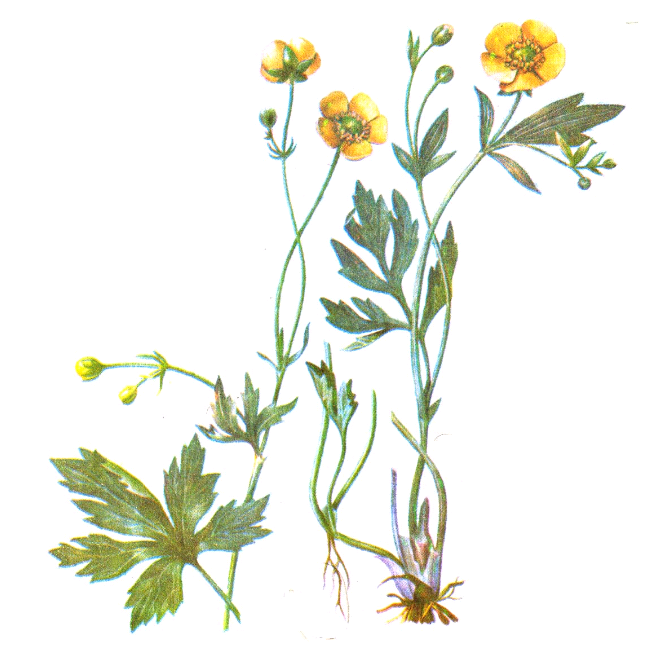
Thoroughly washed ranunculus flowers, its stems, leaves are dried in the attic or under a canopy on fresh air, as dried under the sun, they lose their beneficial properties
The dried raw materials are laid out in bags and stored in a dark room for up to a year. Fresh - should be used immediately after harvesting.
Application
The plant has medicinal properties. Many diseases can be treated creeping buttercup, using it as an external remedy:
- Places on the skin affected by scabies and diathesis are washed with a prepared decoction of buttercup herb;
- For the treatment of tumors, abscesses, crushed fresh leaves are applied;
- With osteochondrosis, arthritis, radiculitis, myositis, compresses are made from a fresh plant;
- When aching in the legs, pounded flowers, stems, and also creeping buttercup leaves are used, they are applied as a patch to abscesses for their rapid maturation, or instead of mustard plaster;
- For warts, scrofula, slurry from a plant or juice from fresh grass is used;
- In diseases of the liver, stomach, a decoction of flowers is used in small quantities.
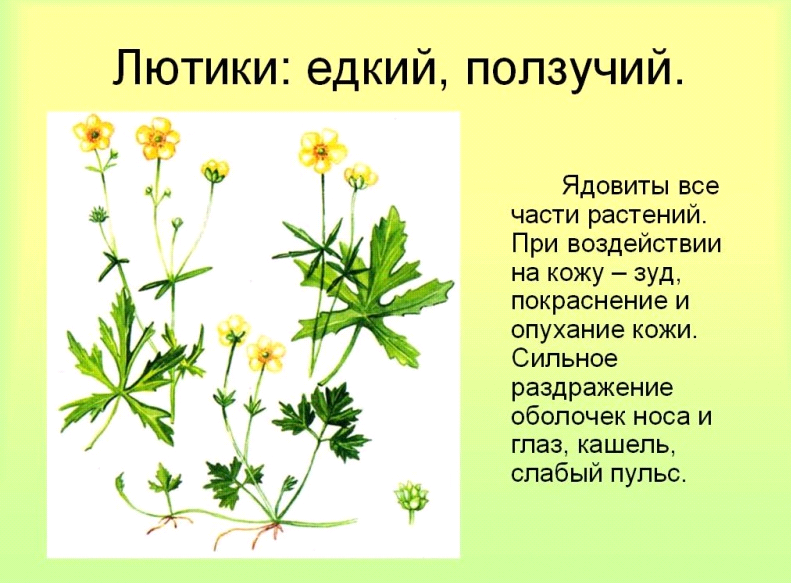
Buttercup creeping is a poisonous plant, so only after consulting a doctor, it can be used. Using it in high doses can cause great harm to the body. Outwardly, you should not leave it on the skin for more than 15 minutes, as you can get severe irritation and burns.
They have become an integral part of songs, poems and legends, and this despite the far from gentle name that the flower received for its poisonousness and blistering action. Only now they decided not to call this plant "fierce" by applying caressing form"buttercup". ABOUT healing properties this plant, its types, medicinal properties and applications will be discussed in this article.
Description of the plant buttercup (Ranunculus)
Buttercup is a perennial or annual plant belonging to the Buttercup family.Buttercup in popular literature is called "ranunculus" (a transliteration of the Latin name "ranunculus" is used, which means "little frog" in Latin). The fact is that wild buttercups, like frogs, prefer wet and swampy "habitats", which should be sunny and warm enough.
In Rus', this plant was given the name "buttercup" for its blistering action.
What does buttercup look like?
Buttercup is a rhizomatous or root-tuberous plant with erect, ascending or prostrate stems that often root at the nodes.The stalk of buttercup reaches a height of 20 cm to 1 m.
The leaves of the plant can be whole, spatulate, palmately or pinnatipartite, they are arranged in the next order. The petals at the base have a honey hole (it can be bare or covered with a small scale). The lower stem leaves, like the basal leaves, are 5–6 cm long and about 5 cm wide.
Buttercup flowers are solitary or collected in an inflorescence. The diameter of the flowers is 1 - 2 cm.
The fruit of the flower is a polynutlet, in which naked or hairy seeds are formed, which are both flat and convex.
What color are buttercups?
The color range of buttercups is very diverse. This flower can be yellow, white, pink, red, lilac and blue.Where does it grow?
Buttercup grows almost throughout Europe, the Caucasus and Western Siberia, Asia, the Alps, and the Pyrenees, but most often this plant can be found in the wild in the temperate zone of the Northern Hemisphere.In Russia, buttercup is common in the European part of the country (with the exception of the Far North, as well as the south).
This beautiful flower prefers forest and floodplain meadows, sparse forests, banks of streams and rivers, marshes.
Buttercup species
About 600 species of buttercups are known, distributed throughout the world, while many varieties have medicinal properties, due to which they are used in folk medicine.For medical purposes, the following types of buttercup are used:
- caustic (or night blindness);
- poisonous;
- creeping;
- burning;
- many-flowered;
- field;
- water (or swamp).
Buttercup caustic (night blindness)
The caustic buttercup (or Ranunculus acris) reaches a height of 30 - 100 cm. The stem of this species of buttercup is erect and covered with pressed hairs, while the stem begins to branch upwards.The rhizome of the caustic buttercup is short, numerous roots extend from it, which are collected in a bundle.
Bright golden yellow flowers correct form located at the ends of branches. The leaves of the caustic buttercup can have a different shape.
The plant got its second name - "night blindness" - for the reason that the substance protoanemonin, which is part of the plant, irritates the mucous membranes of the eyes, causing severe pain, tearing, and temporary blindness (they say that chickens that ate buttercup grass , blind).
Application in medicine
For medicinal purposes, the caustic buttercup herb is used, which contains a large amount of biologically active substances, including protoanemonin, saponins, tannins, flavonoids and glycosides.
The action of preparations of buttercup caustic:
- Neutralization of microbes and bacteria.
- CNS stimulation.
- An increase in the number of red blood cells and hemoglobin in the blood.
- Removal of inflammation.
- Strengthening.
- Stimulation of metabolism.
- Stop bleeding.
- skin diseases;
- gout;
- neuralgia;
- skin tuberculosis;
- burns;
- boils;
- rheumatism;
- headaches;
- eczema;
- malaria;
- arthritis;
- fever;
- liver diseases;
- colds;
- ascites;
- lymph nodes;
- internal bleeding;
- warts;
- lipoma;
- scurvy;
- impetigo;
- hydradenitis;
- seals of the spleen;
- menstrual irregularities;
- golden staphylococcus.
Buttercup poisonous
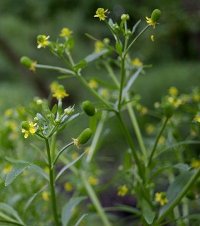 This species of buttercup, whose official name is Ranunculus sceleratu, is an annual or biennial plant with a straight, hollow and branched stem, the height of which can vary between 10 - 70 cm.
This species of buttercup, whose official name is Ranunculus sceleratu, is an annual or biennial plant with a straight, hollow and branched stem, the height of which can vary between 10 - 70 cm. The leaves of the poisonous ranunculus are shiny and slightly fleshy.
The light yellow flowers of the plant do not differ in large sizes (for example, their diameter is 7 - 10 mm).
Interesting fact! The seeds of the poisonous ranunculus are protected by the seed coat from excessive moisture (in other words, from getting wet), while under the epidermis there are large air-bearing corky cells, thanks to which the seed does not sink in water.
Application in medicine
Because of high degree poisonous plant is mainly used externally. For example, plant juice diluted with water is used to treat skin areas affected by a disease such as scabies. In addition, inflamed eyes or festering wounds are washed with non-concentrated poisonous ranunculus juice.
Crushed fresh leaves of the plant are applied to warts, which contributes to their rapid removal.
Fresh crushed buttercup herb can be used as a pull-out patch, to create artificial boils or blisters, and as an effective pain reliever and distraction.
A water infusion of grass will also help, for which it is enough to soar your legs in it.
Inside, decoctions and infusions of poisonous ranunculus are taken for such diseases:
- diseases of the female genital organs;
buttercup creeping
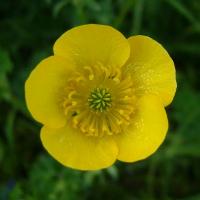 Ranunculus repens (or creeping ranunculus), like the two species described above, is common in Russia, and is very poisonous.
Ranunculus repens (or creeping ranunculus), like the two species described above, is common in Russia, and is very poisonous. This perennial species Buttercup, rarely exceeding 40 cm in height, has an ascending or creeping stem, which often takes root (the stem can be either bare or pubescent in places).
The plant is crowned with a golden yellow, brilliant flower that opens between May and August.
Buttercup creeping prefers moist, shaded, alluvial soils, so it can often be found on river and lake shores, forest swamps, along fields and roads.
Application in medicine
In therapeutic doses, creeping buttercup has analgesic, antimicrobial, wound healing, and tonic properties.
In diseases such as rheumatism, scrofula and scabies, buttercup grass is applied to the affected areas (tumors and abscesses). The stem of the plant is used to dissolve or hasten the maturation of abscesses.
With fungal lesions of the skin, the aerial part of the plant is used as a wash or compress.
Fresh ranunculus grass is externally used in the treatment of the following pathologies:
- myositis;
- rheumatic pains;
- scrofula.
Creeping ranunculus flowers are used in the treatment of malaria, for which, 8-10 hours before the attack, crushed (or pounded) fresh flowers of the plant are applied to the wrists (on the zone of probing the pulse), which will help mitigate or stop the attack.
Important! When using buttercup creeping as an external agent, long-term exposure to the skin should be excluded, since this plant has a strong irritating effect on the skin (in some cases, such an action can provoke tissue necrosis and skin ulceration).
Banewort
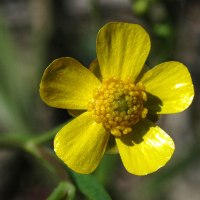 Buttercup burning (or Ranunculus flammula) has a low erect or rising stem (about 20 - 50 cm).
Buttercup burning (or Ranunculus flammula) has a low erect or rising stem (about 20 - 50 cm). The basal leaves of the plant are long-petiolate, while they are noticeably wider than the upper ones. But the upper leaves of this species of buttercup are sessile.
Single light yellow flowers are quite small (no more than 12 mm in diameter). The fruit of the plant is an ovoid one-seeded leaflet.
Burning ranunculus grows on damp soils, mainly near water bodies.
Application in medicine
For medicinal purposes, a plant herb containing gamma-lactones and coumarins is used.
So, the juice of the aerial part of the burning ranunculus is diluted with water (2-3 drops of juice go to half a glass of water) and is taken for scurvy.
An infusion of the herb of this type of buttercup in folk medicine is used for. To prepare the infusion, one tablespoon of well-chopped fresh ranunculus herb is poured with a liter of boiling water and infused for one hour, after which the infusion is filtered and consumed one tablespoon no more than four times a day.
Buttercup multiflora
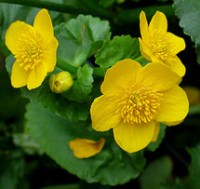 Ranunculus polyanthemus (or multi-flowered ranunculus) has a tall (up to 60 - 80 cm) erect and pubescent stem (leaf petioles also have pubescence).
Ranunculus polyanthemus (or multi-flowered ranunculus) has a tall (up to 60 - 80 cm) erect and pubescent stem (leaf petioles also have pubescence). The leaves of ranunculus multiflora have wedge-shaped or linear lobes. Bright yellow flowers, the diameter of which does not exceed 3 cm, open in the first half of June, while flowering ends in late July - early August.
This species of buttercup is found wild in meadows and forests.
Application in medicine
For therapeutic purposes, the stems, leaves and flowers of the plant are used, containing protoanemonin, C, carotene and flavonoids.
Preparations based on ranunculus multiflorum, which have tonic, analgesic, antimicrobial and wound healing effects, are used for:
- pain syndrome of various etiologies (gastric, headache, neuralgic pains);
- rheumatism;
- gout;
- abscesses;
- wounds;
- boils;
- malaria;
- skin;
Buttercup field
 Field buttercup (official name Ranunculus arvensis) prefers moderately acidic, poorly aerated, waterlogged and calcareous, loamy soils.
Field buttercup (official name Ranunculus arvensis) prefers moderately acidic, poorly aerated, waterlogged and calcareous, loamy soils. This type of buttercup has yellow or golden single apical flowers and deeply dissected leaves.
An upright and branched (almost naked) stem reaches a height of 60 cm.
Buttercup field is most often found in hayfields or pastures.
Preparations based on buttercup field are distinguished by a tonic and mild laxative effect. So, the skin of the roots of the plant and the seeds are used to relieve heat and tone the body. The aerial part of the plant is used for radiculitis, pustular skin rashes and furunculosis.
Field buttercup tubers are used in the production of nutritional supplements.
Buttercup water (marsh)
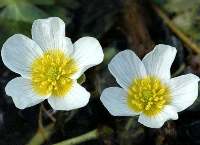 Buttercup water (it is also called swamp, while the official name of this plant is Ranunculus aquatica) is perennial light green in color with a thin and bare stem, as well as small white-yellow flowers that rise above the water surface.
Buttercup water (it is also called swamp, while the official name of this plant is Ranunculus aquatica) is perennial light green in color with a thin and bare stem, as well as small white-yellow flowers that rise above the water surface. The marsh buttercup can grow at depths ranging from 20 cm to up to 2 m.
The length of the leaves is 3 - 4 cm, while the pedicel of the plant is not much longer than the leaves.
The flowers of the water ranunculus in diameter are 8 - 12 mm in diameter.
Easily falling petals of the plant are almost twice as long as the sepals. The fruits are grayish in color, slightly bristly upwards.
This plant, which has white medium-sized flowers and underwater leaves, dissected into thin filamentous lobes, is common in the shallow coastal zone of the countries of the East, in Siberia, Europe, America and Africa. Water buttercup grows in stagnant, and, most importantly, slowly flowing water bodies (in some cases, water buttercup can be found near the coast, in sedge forests, as well as on waterlogged and silty soil).
For therapeutic purposes, the stems and leaves of the plant containing saponins and protoanemonin are used.
To prepare a decoction of water buttercup, one tablespoon of the leaves of the plant should be poured with a glass of water. The product is boiled for three minutes, infused for an hour, filtered and taken in 1 - 2 tbsp. three times a day. Such a decoction is used as a means of stimulating the functions of the genital organs.
Important! Buttercup, which has an irritating effect on the digestive tract when taken orally, is recommended to be used as a topical preparation and only under the supervision of a physician.
Important! All of these plant species have an almost identical set of useful substances, therefore they can be used in medicine on an equal footing.
Collection and preparation of buttercup
The medicinal raw material of the buttercup is the aerial part of the plant, which can be used both fresh and dried.The plant is harvested during the period of fruit formation, but the flowers must still be present on the stem.
When collecting raw materials, it is better not to tear off, but carefully cut off the stem of the plant, while it is important that the root, which is practically not used in medicine, remains in the ground (and the person will benefit from the plant, and after a certain time the buttercup will be able to please again with its beauty and healing properties).
The collected flowers, stems and leaves are thoroughly washed, after which they are sent to dry in the attic (you can dry the raw materials in the open air, but always under a canopy, because when dried under the sun, all the useful substances of the buttercup will evaporate).
Important! Buttercup is very irritating to the mucous membranes of the eyes, nose, larynx, and also internal organs, as a result of which, when in contact with the aerial part of the plant, redness and blisters form on the skin. Therefore, it is recommended to collect ranunculus grass (especially caustic) in closed clothing and thick gloves.
When do buttercups bloom?
Buttercups bloom from mid-April until the month of July (it all depends on the type of buttercup). An exception is the water ranunculus, which blooms from June to October.How to store?
Dried raw materials are stored in paper bags in a dark place for no more than a year. Fresh raw materials must be used immediately after collection.The composition and properties of buttercup
ProtoanemoninIt is a volatile poison with a pungent odor and a burning taste.
In small doses, this substance stimulates the functions of the central nervous system, activates the elements of the reticuloendothelial system, neutralizes microbes and increases the content of red blood cells and hemoglobin in the blood.
Coumarins
Action:
- obstruction of blood clotting;
- inhibition of the development of tumor cells;
- acceleration of the wound healing process;
- toning the body and saturating it with vitamins of group P;
- prevention of blood clots.
Action:
- slow heart rate;
- normalization of cardiac activity;
- increased systole and lengthened diastole;
- decrease in blood pressure indicators;
- normalization of blood circulation.
Action:
- promoting the excretion of sputum;
- fever removal;
- increased excretion of bile;
- lowering blood pressure.
This class of substances, forming a biological film, protects tissues and cells of the body from adverse effects ( we are talking about chemical, bacterial, and also mechanical action). Also, tannins strengthen blood vessels and significantly constrict blood vessels.
alkaloids
Action:
- helping to stop bleeding;
- removal of pain syndrome;
- normalization of the central nervous system;
- strengthening of blood vessels;
- preventing the growth of neoplasms;
- pressure reduction ;
- decrease in body temperature.
Action:
- normalization of redox processes;
- inhibition of enzymes that destroy hyaluronic acidresponsible for the normal formation of cartilage tissue;
- strengthening the walls of blood vessels and increasing their elasticity;
- prevention of sclerotic lesions of capillaries;
- elimination of free radicals.
 Action:
Action: - normalization of the functions of the central nervous system;
- stimulation of the endocrine glands;
- facilitating the assimilation of required element like iron;
- normalization of the process of hematopoiesis;
- removal from the body of harmful compounds that provoke the development of malignant tumors.
Carotene
Action:
- reducing the risk of developing cancer;
- regulation of the process of protein synthesis;
- strengthening bones and teeth and promoting their formation;
- normalization of metabolism;
- warning process premature.
Action:
- decreased vascular tone;
- increase in hemoglobin content;
- increased excretion of stones;
- binding and subsequent removal of radionuclides.
Action:
- rejuvenation of tissues and cells of the body;
- elimination of foci of inflammation;
- regulation and normalization of metabolism; . Often, such drugs are used as an insecticide (a chemical preparation designed to kill harmful insects: for example, a decoction of a plant will help disinfect things from bedbugs).
- induce vomiting;
- take activated charcoal;
- perform gastric lavage;
- call an ambulance.
- breastfeeding period;
- individual intolerance.
Pounded buttercup flowers are caustic, as well as creeping, and are used in folk medicine instead of mustard plasters and blister patches. Flowers also help with aching in the lower extremities, for which it is enough to rub the sore joints with fresh crushed flowers.
The flowers of the plant are used as a remedy for malaria.
Root and tubers
Powder from the roots and tubers of buttercup is used to treat malignant and remove warts. From the root of the plant, traditional healers have long prepared vaginal suppositories that promote pregnancy (self-medication can have negative consequences, therefore, it is necessary before using folk remedies based on buttercup).seeds
Little is known about the healing effect of ranunculus seeds on the body: for example, there are references to the use of decoctions from the seeds of this plant, which has a basis, since buttercups have antipyretic and tonic properties.Leaves (grass)
Traditional medicine widely uses fresh buttercup leaves as an effective abscess and analgesic, indicated in the treatment of ulcers, boils, rheumatism, scrofula, myositis. So, ranunculus grass is used as an blistering patch for old carbuncles that do not open for a long time. An infusion of the fresh leaves is used in small quantities in the treatment of headaches and stomach pains.Fresh leaves of the plant in crushed form are applied to the places where tumors and sprains appear.
Buttercup is rightfully considered the first assistant in the removal of warts and the treatment of fungal diseases. A decoction of this part of the plant is indicated for washing areas of the skin affected by scabies.
Gruel from the fresh herb of the plant, mixed with vinegar, helped to cure or reduce the manifestation of diseases such as leprosy, eczema, fox disease (we are talking about hair loss), for which it was enough to treat the affected areas of the skin with such a mixture.
Although ranunculus is not used in traditional medicine, recent research indicates that this plant is effective in combating skin tuberculosis.
It should be remembered that the buttercup is a poisonous plant, so all parts of it should be taken with extreme caution and only after consulting a doctor, who, if necessary, will determine the exact dosage.
The use of buttercup in medicine
 Buttercup is used in both traditional and folk medicine in Eastern, Northern and Central European countries.
Buttercup is used in both traditional and folk medicine in Eastern, Northern and Central European countries. So, infusions and decoctions from dried raw materials are used in the treatment of salt deposits, various inflammations on the skin.
The herb of the plant is used as an effective pain reliever for neurological, headache, stomach and rheumatic pains.
Buttercup has found application in the treatment of colds, oncological and infectious diseases, including influenza, gout, ascites, pancreatic cancer.
A decoction of flowers, taken in small quantities, will help to cope with diseases of the liver and stomach, as well as rabies.
Fresh ranunculus grass is widely used in homeopathy in the treatment of skin diseases, and neuralgia.
Infusion
An infusion of buttercup herb is taken as an internal or external remedy for skin diseases, colds, and treatment of difficult-to-heal wounds.To prepare the infusion 0.5 tbsp. dried herbs are placed in a thermos and brewed with 500 ml of boiling water. The remedy, infused for half an hour, is filtered, after which it is used to wash the wounds. When taken internally, the dosage of this infusion is 1 tbsp. three times a day. With the same remedy, you can rinse the inflamed mucous membrane of the throat several times a day.
Tincture
Buttercup extract has strong bactericidal, regenerating and rejuvenating properties, due to which it is used for muscle pain, diseases of the throat and oral cavity. In addition, buttercup tincture can be used to rinse your hair, which will strengthen the hair follicle and give your hair a healthy look.50 buttercup flowers are poured with 500 ml of alcohol, after which the product is mixed well and infused for three weeks. The filtered tincture is used externally as a rub. Internal reception of tincture is contraindicated!
Buttercup ointment
An ointment prepared from buttercup flowers and pork fat in a ratio of 1: 4 is used as an external remedy for colds and viral diseases, with inflammation of the lymph nodes. So, the chest and throat are rubbed with ointment (these parts of the body are wrapped in a woolen scarf and left all night). Such treatment is carried out daily, until the disease is completely cured.ranunculus juice
Cotton wool moistened with ranunculus juice is applied to aching teeth. Also, weak ranunculus juice is used for developing (it is enough to moisten the eyes with juice several times a day).Important! Highly concentrated juice from buttercup leaves can cause burns to the skin and mucous membranes.
Buttercup unifolia: application - video
What is the reason for such an effect on the body of buttercup? The fact is that this plant contains the substance protoanemonin, which, when applied topically, provokes severe irritation of the skin of the eyes, as well as the mucous membranes of the eyes, nose and larynx. Such irritation is manifested by lacrimation, sharp pain in the eyes, runny nose, salivation, coughing, and in some cases, spasm of the larynx. When administered subcutaneously, ranunculus preparations cause rather deep damage and destruction of tissues (up to necrosis) at the injection sites.
Contraindications to the use of buttercup preparations are:
Buttercup Recipes



